
RIFT VALLEY PROVINCE, KENYA, NOVEMBER 2009: An emaciated Samburu Elder pastoralist stands in his burnt-out cattle boma at at time of the worst drought in Kenya for the last 100 years, 20 November 2009. It is traditional for the Samburu and other pastoralist groups to burn their bomas if they lose their cattle to disease or drought, it is done as a cathartic excercise to remove the bad luck of the old and hopefully bring about better luck for the future. Many Samburu have lost up to 95% of their herds, making starvation a real threat over the coming months. The drought has brought about increasingly deadly conflict between pastoralists as well as conservationists all competing for grazing land. (Photo by Brent Stirton/Reportage by Getty Images.)

RIFT VALLEY PROVINCE, KENYA, NOVEMBER 2009: Images of a massacre site where the Pokot tribesman came out of the Rift Valley, their traditional area, and attacked a Samburu village over cattle grazing rights in the north of Kenya at a time of the worst drought in the region for the last 100 years, 20 November 2009. 25 Samburu men, women and children were killed in the attack, over 50 cattle were shot and over 300 died later in the week from not being able to access grazing land because of the threat of the Pokot. The drought has brought about increasingly deadly conflict between pastoralists as well as conservationists all competing for grazing land. (Photo by Brent Stirton/Reportage by Getty Images.)

LAISAMIS, MARSABIT SOUTH, NORTH KENYA: A Kenya Police reservist guards Borana cattle which were raided by Rendille Moran tribesman in retaliation for a huge Boran raid in September 2009, North of Kenya, 27 February 2010. The police are being assisted in this matter by the members of the Melako Conservancy who are formed from the local community and are involved in conservancy and other peace-keeping affairs for the region. A cattle exchange is planned between the Rendille and the Borana which will be mediated by the Melako conservancy comittee and the police. North Kenya is currently undergoing an intense disarmament process in which the Kenyan Army and Administrative Police are trying to disarm the local tribes, mainly the Borana, the Samburu, the Rendille and Somalis, amongst others. This process is controversial as the tribes feel they have to have weapons to protect against cattle raids from the other tribes. This is an age old conflict but the Rendille and Samburu feel especially vulnerable as the Borana exist on both sides of the border region with Kenya and can thus access weapons from their fellow tribesmen on the Ethiopian side. This is also true of the Somalis and as such the Rendille and Samburu feel especially vulnerable. Although weapons have been collected there are many stories of violence by the Kenyan authorities against the tribes in this process, especially against the Samburu and the Rendille. This process has not been helped by the fact that many of the biggest cattle raids in history have been made by the Borana against the Rendille and Samburu in the last year. It looks unlikely that of the 23 000 weapons allegedly in the field only a few hundred have thus far been collected. (Photo by Brent Stirton/ Reportage by Getty Images.)

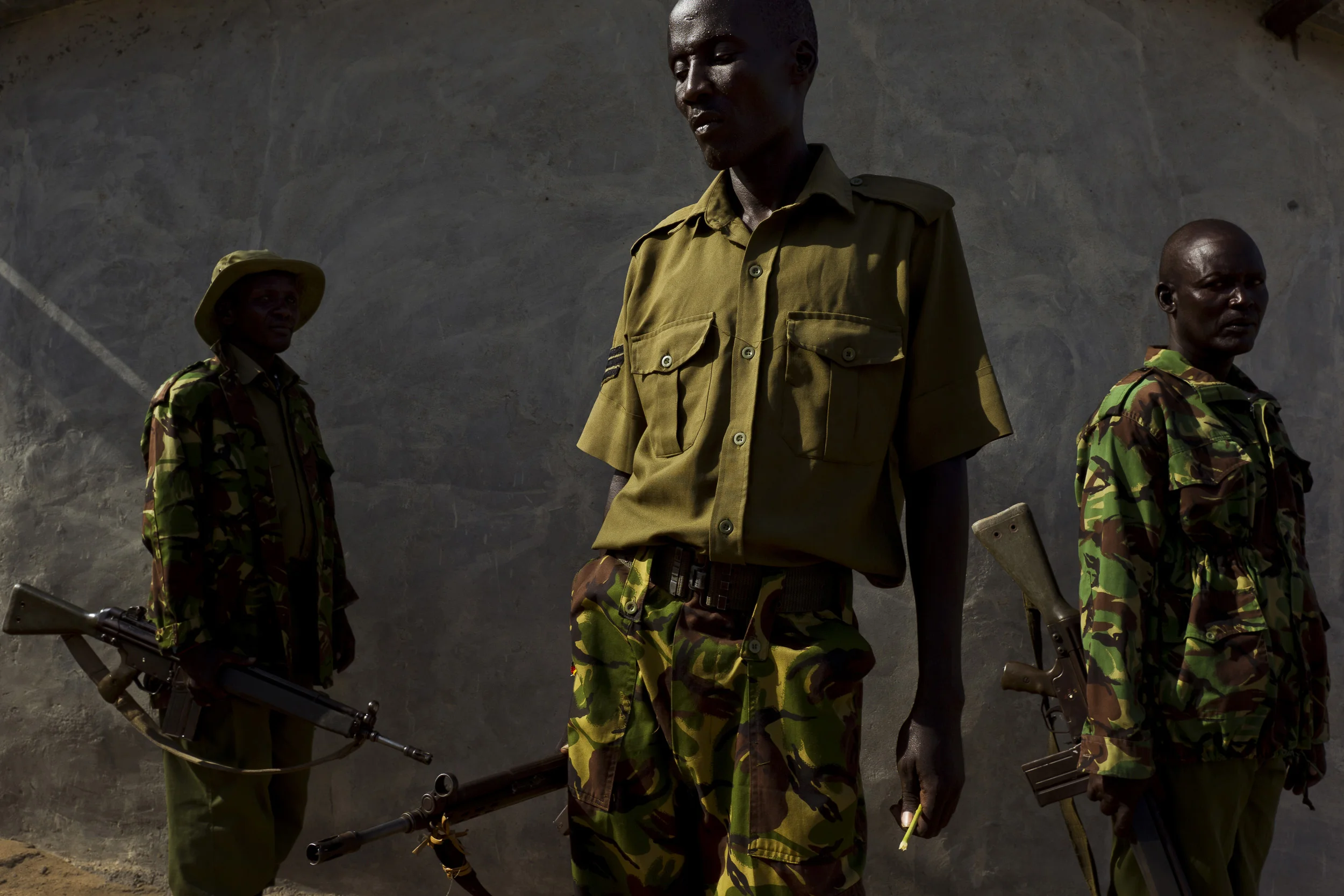
ILERET, LAKE TURKANA, NORTH KENYA, MAY 2010: Dasenetch men who are members of the Kenya Police Reserve on patrol through Dasenetch villages in the Ileret district, Lake Turkana, North Kenya, 23 May 2010. These men are an inadequate defence against cattle raids from the Gabra tribe or other Southern Ethiopian tribes who traditionally make up the enemies of the Dasenetch people. Kenya is currently undergoing a controversial and intense disarmament process in which the Kenyan Army and Administrative Police are trying to disarm the local tribes, mainly the Borana, the Samburu, the Rendille, the Dasenetch, the Gabra, the Turkana as well as the Somalis, amongst others. This process is controversial as the tribes feel they have to have personal weapons to protect against cattle raids from the other tribes. This is an age old conflict. Many Kenya based tribal groups feel especially vulnerable as many other tribes often exist on both sides of the Kenya border regions for Sudan, Somalia and Ethiopia and can thus access weapons from their fellow tribesmen across the border despite the disarmament process within Kenya. Although weapons have been collected there are many stories of violence by the Kenyan Security authorities against the pastoralist tribes in this process. This process has not been helped by the fact that some of the biggest cattle raids in history have been made in the last year. It looks unlikely that of the alleged 23 000 weapons allegedly in the field will in actual fact be confiscated. Only a few hundred have thus far been collected and many pastoralists have fled with their weapons or hidden them and endured the brutal search by Kenyan security forces in silence. (Photo by Brent Stirton/ Reportage by Getty Images.)

KOYA, MARSABIT SOUTH, NORTH KENYA: Melako Conservancy Scouts patrol Koya, an area which became a vast no mans land after extensive cattle raiding between the Rendille tribe and the Borana tribe, Koya, north Kenya, 28 February 2010. The Rendille ended up moving 42 kilometers away and the Borana also pulled back, leaving a viable pastoral and conservation area deserted and contentious. The Melako Conservancy community group with the help of the Northern Rangelands trust are trying to rehabilitate the area for both Pastoralists and for wildlife tourism. The scouts are appointed by the community and with the help of a few Kenya Administrative Police are trying to secure the area and the wildlife so that people may safely return and invest in the area for both their cattle and tourism returns. (Photo by Brent Stirton/ Reportage by Getty Images.)

KOYA, MARSABIT SOUTH, NORTH KENYA: Rendille Morans dig water for goats and camels in an area designated as sustainable by the Melako Conservancy comittee, Koya, North Kenya, 28 February 2010. The Melako Conservancy is run by the local community with advice from the Northern Rangeland Trust, an NGO which seeks to advise communities on sustainable pastoral practises and ways to leverage wildlife for conservancy and income purposes. In this area they have been instrumental in advising the locals how to graze cattle sustainably in a controlled pattern and keep them out of sensitive wildlife areas so that they can build viable tourism from which the community derives an annual guaranteed income. (Photo by Brent Stirton/ Reportage by Getty Images.)

RIFT VALLEY PROVINCE, KENYA, NOVEMBER 2009: Images of a massacre site where Pokot tribesman came out of the Rift Valley, their traditional area, and attacked a Samburu village over cattle grazing rights in the north of Kenya at a time of the worst drought in the region for the last 100 years, 20 November 2009. 25 Samburu men, women and children were killed in the attack, over 50 cattle were shot and over 300 died later in the week from not being able to access grazing land because of the threat of the Pokot. The drought has brought about increasingly deadly conflict between pastoralists as well as conservationists all competing for grazing land. (Photo by Brent Stirton/Reportage by Getty Images.)



RIFT VALLEY PROVINCE, KENYA, NOVEMBER 2009: A Samburu elder with the last of his drought-stricken cattle competes with wildlife for grazing in the famous Lewa Wildlife Conservancy in the north of Kenya at a time of the worst drought in Kenya for the last 100 years, 20 November 2009. Conservation areas have had no choice but to come to arrangements with the pastoralists, in this case allowing them to graze their cattle in the reserve for parts of the day, moving them out at night. This has had a negative effect on tourism revenues as well as on conservation priorities in the world's most important wildlife region. The drought has brought about increasingly deadly conflict between pastoralists as well as conservationists all competing for grazing land. (Photo by Brent Stirton/Reportage by Getty Images.)

LOLIONDO, NORTHERN TANZANIA, NOVEMBER 2012: Images from a Masai coming –of-age ceremony in a remote Masai village in Loliondo, Northern Tanzania, 2 November 2012. Two of the young warriors in this ceremony are wearing a Lion Mane head-dress from a lion they speared 3 years ago. The Masai have a long history of lion-killing, both as a proving ground for young warriors in their ascent to manhood and also to protect their cattle from lion attacks. This is an illegal activity and 3 years ago a number of young warriors were arrested and jailed for this offence. Illegal lion killing continues amongst the Masai today, but as lion numbers dwindle, this activity is also increasingly rare to find. Conflict between the pastoralist Masai and the lion is an age-old phenomenon. (Photo by Brent Stirton/Reportage for National Geographic Magazine.)

BOR, SOUTH SUDAN, FEBRUARY 2013: Scenes with cattle in the countryside close to Bor, South Sudan, February 7, 2013. Cattle are very highly prized in the economy of South Sudan and are often a part of the price of dowry for a young woman's hand in marriage. This is a long standing part of the economy for families and lends tremendous value to cattle. This often leads men to assume a sense of ownership over the woman. Early marriage is common in Sudan, with girls as young as 12 essentially sold into a life of indentured labour and childbirth. There are moves to change this in the legal system in South Sudan but this fledgling country is struggling with many issues and the fact that early marriage is a long established part of the culture is making this transition in thinking very difficult. (Photo by Brent Stirton/Reportage for Human Rights Watch.)

BOR, SOUTH SUDAN, FEBRUARY 2013: Scenes with cattle in the countryside close to Bor, South Sudan, February 7, 2013. Cattle are very highly prized in the economy of South Sudan and are often a part of the price of dowry for a young woman's hand in marriage. This is a long standing part of the economy for families and lends tremendous value to cattle. This often leads men to assume a sense of ownership over the woman. Early marriage is common in Sudan, with girls as young as 12 essentially sold into a life of indentured labour and childbirth. There are moves to change this in the legal system in South Sudan but this fledgling country is struggling with many issues and the fact that early marriage is a long established part of the culture is making this transition in thinking very difficult. (Photo by Brent Stirton/Reportage for Human Rights Watch.)
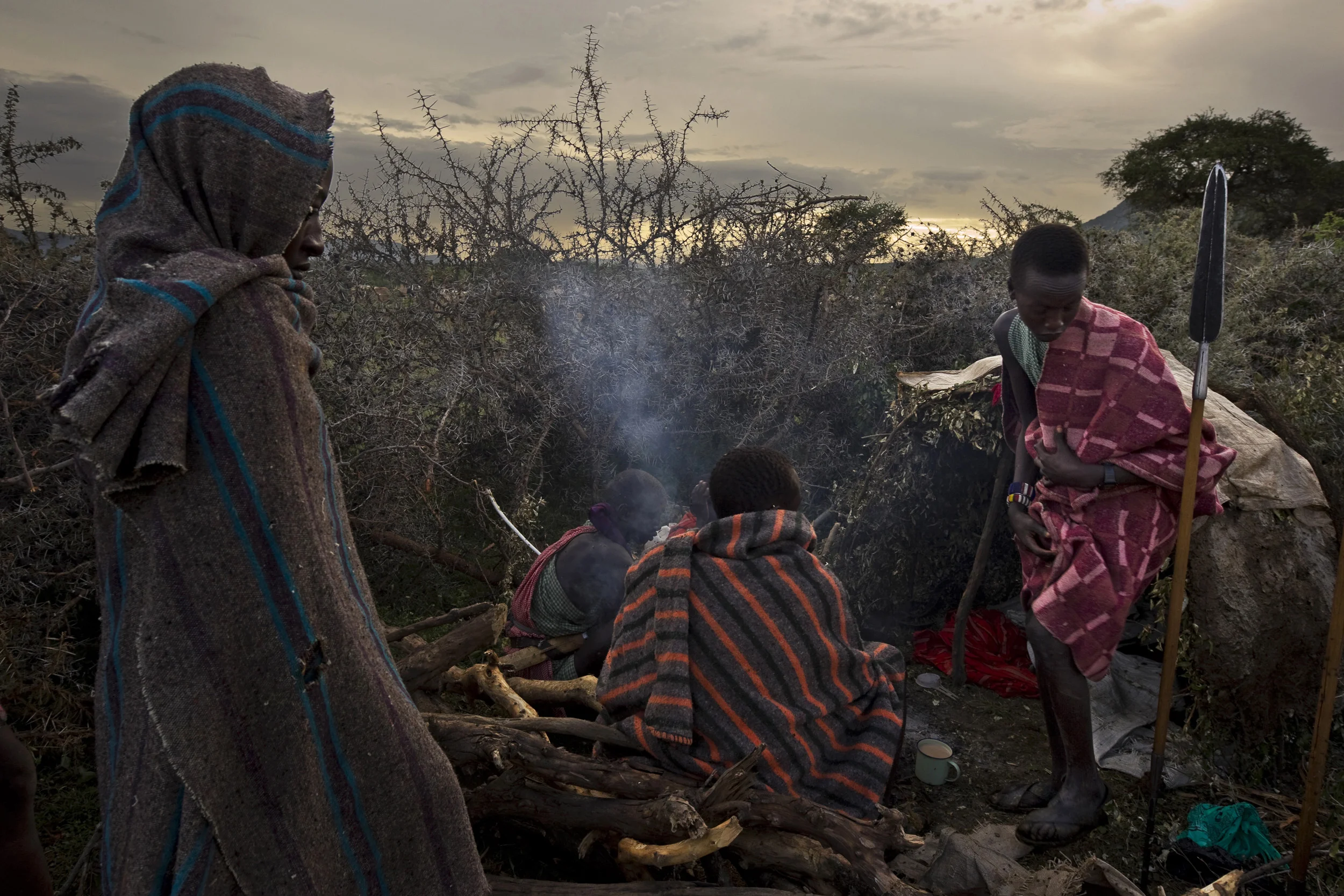
Young Masai boys guard cattle from lion and other predators

Flies cover a young boys face in a traditional cattle manyata
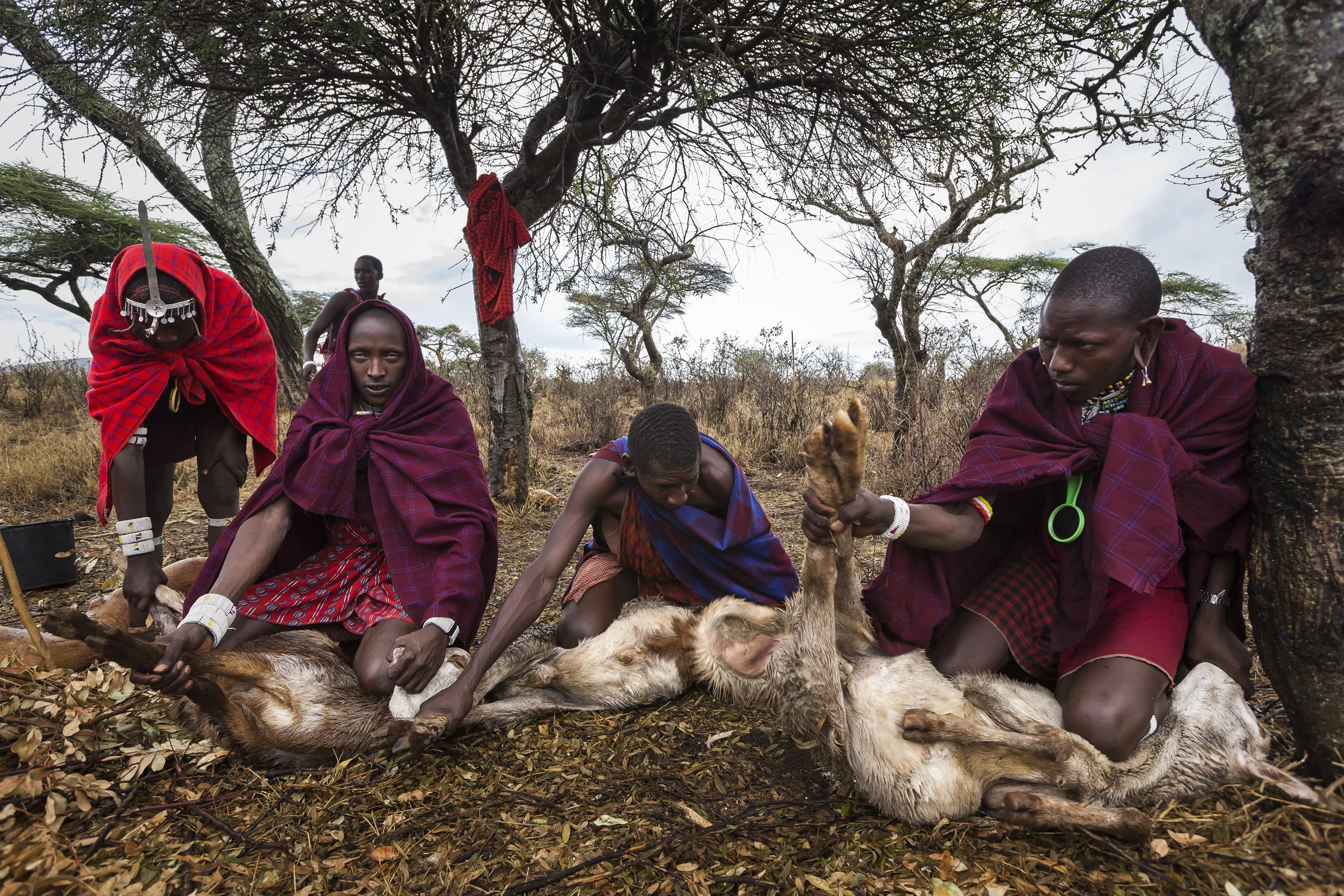
Goats being killed by suffocation and then butchered for a coming of age ceremony.


A young Masai boy heals a burnt hand inside a recently killed goat stomach, a traditional cure amongst Masai.

LOLIONDO, NORTHERN TANZANIA, NOVEMBER 2012: Images from a Masai coming –of-age ceremony in a remote Masai village in Loliondo, Northern Tanzania, 2 November 2012. One of the young warriors in this ceremony is wearing a Lion Mane head-dress from a lion he speared 3 years ago. The Masai have a long history of lion-killing, both as a proving ground for young warriors in their ascent to manhood and also to protect their cattle from lion attacks. This is an illegal activity and 3 years ago a number of young warriors were arrested and jailed for this offence. Illegal lion killing continues amongst the Masai today, but as lion numbers dwindle, this activity is also increasingly rare to find. Conflict between the pastoralist Masai and the lion is an age-old phenomenon. (Photo by Brent Stirton/Reportage for National Geographic Magazine.)

LOLIONDO, NORTHERN TANZANIA, NOVEMBER 2012: Images from a Masai coming –of-age ceremony in a remote Masai village in Loliondo, Northern Tanzania, 2 November 2012. One of the young warriors in this ceremony is wearing a Lion Mane head-dress from a lion he speared 3 years ago. The Masai have a long history of lion-killing, both as a proving ground for young warriors in their ascent to manhood and also to protect their cattle from lion attacks. This is an illegal activity and 3 years ago a number of young warriors were arrested and jailed for this offence. Illegal lion killing continues amongst the Masai today, but as lion numbers dwindle, this activity is also increasingly rare to find. Conflict between the pastoralist Masai and the lion is an age-old phenomenon. (Photo by Brent Stirton/Reportage for National Geographic Magazine.)
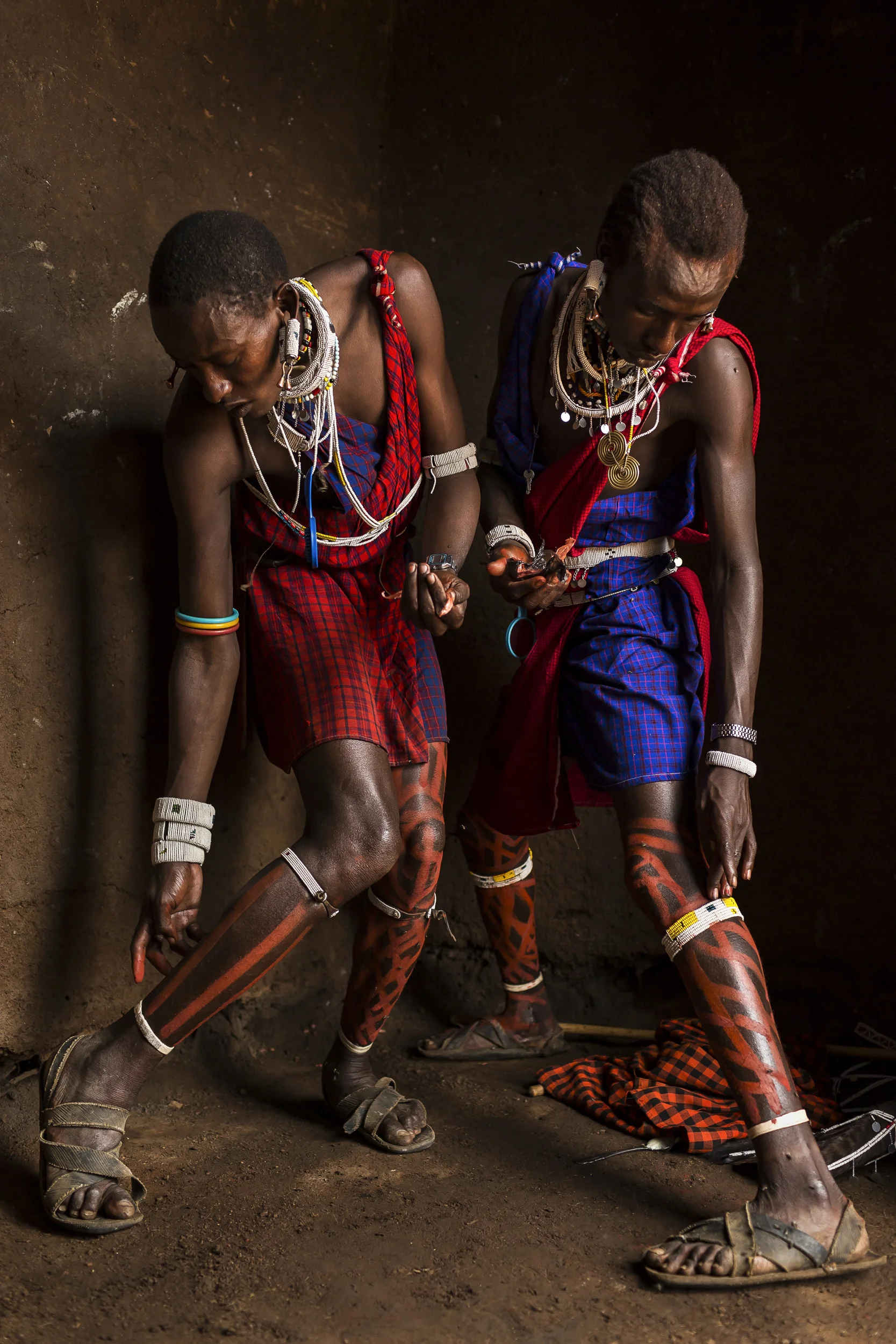
LOLIONDO, NORTHERN TANZANIA, NOVEMBER 2012: Images from a Masai coming –of-age ceremony in a remote Masai village in Loliondo, Northern Tanzania, 2 November 2012. Two of the young warriors in this ceremony are wearing a Lion Mane head-dress from a lion they speared 3 years ago. The Masai have a long history of lion-killing, both as a proving ground for young warriors in their ascent to manhood and also to protect their cattle from lion attacks. This is an illegal activity and 3 years ago a number of young warriors were arrested and jailed for this offence. Illegal lion killing continues amongst the Masai today, but as lion numbers dwindle, this activity is also increasingly rare to find. Conflict between the pastoralist Masai and the lion is an age-old phenomenon. (Photo by Brent Stirton/Reportage for National Geographic Magazine.)

LOLIONDO, NORTHERN TANZANIA, NOVEMBER 2012: Images from a Masai coming –of-age ceremony in a remote Masai village in Loliondo, Northern Tanzania, 2 November 2012. Two of the young warriors in this ceremony are wearing a Lion Mane head-dress from a lion they speared 3 years ago. The Masai have a long history of lion-killing, both as a proving ground for young warriors in their ascent to manhood and also to protect their cattle from lion attacks. This is an illegal activity and 3 years ago a number of young warriors were arrested and jailed for this offence. Illegal lion killing continues amongst the Masai today, but as lion numbers dwindle, this activity is also increasingly rare to find. Conflict between the pastoralist Masai and the lion is an age-old phenomenon. (Photo by Brent Stirton/Reportage for National Geographic Magazine.)

LOLIONDO, NORTHERN TANZANIA, NOVEMBER 2012: Images from a Masai coming –of-age ceremony in a remote Masai village in Loliondo, Northern Tanzania, 2 November 2012. Two of the young warriors in this ceremony are wearing a Lion Mane head-dress from a lion they speared 3 years ago. The Masai have a long history of lion-killing, both as a proving ground for young warriors in their ascent to manhood and also to protect their cattle from lion attacks. This is an illegal activity and 3 years ago a number of young warriors were arrested and jailed for this offence. Illegal lion killing continues amongst the Masai today, but as lion numbers dwindle, this activity is also increasingly rare to find. Conflict between the pastoralist Masai and the lion is an age-old phenomenon. (Photo by Brent Stirton/Reportage for National Geographic Magazine.)

LOLIONDO, NORTHERN TANZANIA, NOVEMBER 2012: Images from a Masai coming –of-age ceremony in a remote Masai village in Loliondo, Northern Tanzania, 2 November 2012. One of the young warriors in this ceremony is wearing a Lion Mane head-dress from a lion he speared 3 years ago. The Masai have a long history of lion-killing, both as a proving ground for young warriors in their ascent to manhood and also to protect their cattle from lion attacks. This is an illegal activity and 3 years ago a number of young warriors were arrested and jailed for this offence. Illegal lion killing continues amongst the Masai today, but as lion numbers dwindle, this activity is also increasingly rare to find. Conflict between the pastoralist Masai and the lion is an age-old phenomenon. (Photo by Brent Stirton/Reportage for National Geographic Magazine.)

LOLIONDO, NORTHERN TANZANIA, NOVEMBER 2012: Images from a Masai coming –of-age ceremony in a remote Masai village in Loliondo, Northern Tanzania, 2 November 2012. Two of the young warriors in this ceremony are wearing a Lion Mane head-dress from a lion they speared 3 years ago. The Masai have a long history of lion-killing, both as a proving ground for young warriors in their ascent to manhood and also to protect their cattle from lion attacks. This is an illegal activity and 3 years ago a number of young warriors were arrested and jailed for this offence. Illegal lion killing continues amongst the Masai today, but as lion numbers dwindle, this activity is also increasingly rare to find. Conflict between the pastoralist Masai and the lion is an age-old phenomenon. (Photo by Brent Stirton/Reportage for National Geographic Magazine.)

KANGATOSA, TURKANA, KENYA, 11 OCTOBER 2014: Turkana tribeswomen greet each other in the traditional way by touching heads. Many greetings in this tribe are meant to mimic the actions of cattle. (Photo by Brent Stirton/Reportage by Getty Images for HRW.)
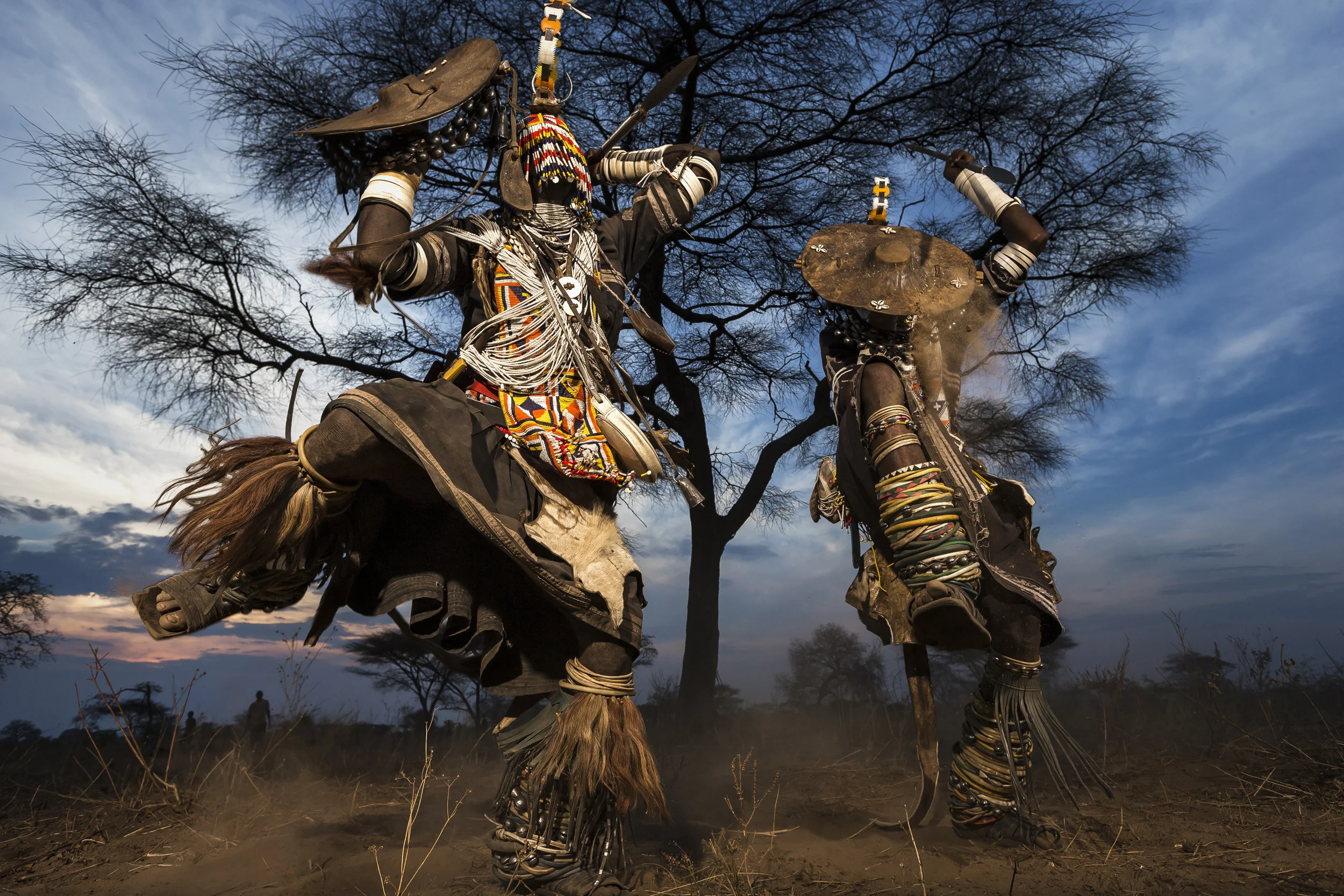
MPIMBWE, WESTERN TANZANIA, OCTOBER 2012: Lion Dancers from the Sakuma tribe perform the story of their lion killing outside a village in rural Mpimbwe, Western Tanzania, October 27, 2012. Lion dancers are men who have killed a lion in defense of their cattle or their village. They are a deeply superstitious people who believe that once they have killed a lion they have to become a lion dancer for 3 to 5 years to avoid going mad. They spend a year or longer preparing with the local witchdoctor and then go from village to village seeing their relatives and dancing while collecting tribute for their bravery. In a time when lion are very scarce in the region, this practice is actively discouraged by conservation organizations and it is slowly dying out. When the dancers appear in the villages, they are often praised and given money, goats and even sometimes a small cow. It is therefore something that some young men aspire to, even going as far as to venture into the local Katavi National Park in pursuit of a lion. (Photo by Brent Stirton/Reportage for National Geographic Magazine.)

LAKE TURKANA, NORTHERN KENYA, MAY 2010: A Dasenetch pastoralist circumcision ceremony in Lake Turkana in North Kenya, 20 May 2010. The Dasenetch are moving slowly into a more modern way of thinking, with more focus on education and alternative livelihoods. They do adhere to certain traditions however and ritualised circumcision is still the most important ceremony in the life of the Dasenetch man. The mixture of western clothing and traditional circumcision rituals is an indicator of a culture in transistion. (Photo by Brent Stirton/Reportage by Getty Images.)

RIFT VALLEY PROVINCE, KENYA, NOVEMBER 2009: Controversial Kenyan Administrative Police search for weapons and suspects as they move through a Samburu village in the region of Samburu National Park in the north of Kenya at a time of the worst drought in Kenya for the last 100 years, 20 November 2009. 2 days after these pictures were taken, 12 people were killed in this area by the AP's, with claims of political motivations behind the killings. Most of the Samburu cattle have succumbed to the worst drought to hit Kenya in over 100 years and many Samburu now face starvation as a result of their decimated herds being unable to supply a steady food supply for communities. Tensions are high as pastoralists tribes as well as conservationists are all competing for tiny pockets of grazing land. Cattle raiding is commonplace and increasingly armed conflict over grazing rights is becoming the norm. (Photo by Brent Stirton/Reportage by Getty Images.)

RIFT VALLEY PROVINCE, KENYA, NOVEMBER 2009: Controversial Kenyan Administrative Police search for weapons and suspects as they move through a Samburu village in the region of Samburu National Park in the north of Kenya at a time of the worst drought in Kenya for the last 100 years, 20 November 2009. 2 days after these pictures were taken, 12 people were killed in this area by the AP's, with claims of political motivations behind the killings. Most of the Samburu cattle have succumbed to the worst drought to hit Kenya in over 100 years and many Samburu now face starvation as a result of their decimated herds being unable to supply a steady food supply for communities. Tensions are high as pastoralists tribes as well as conservationists are all competing for tiny pockets of grazing land. Cattle raiding is commonplace and increasingly armed conflict over grazing rights is becoming the norm. (Photo by Brent Stirton/Reportage by Getty Images.)

LOWARENGAK, TURKANA, KENYA, 10 OCTOBER 2014: Images from an internally displaced Turkana community who have been moved off their land by Dassanech tribesman who raided their cattle and killed their people, Turkana, Kenya. These Turkana now practise fishing as opposed to their traditional pastoralism as their main means of subsistence. The Dassenech have in fact come illegally over the Ethiopian border into Turkana land. They were pressured by sugar cane farms on the lower Omo river which is the main tributary for Lake Turkana, the largest desert lake in the world. These sugar cane farms robbed the Dassenech of tradional grazing land and water rights and so they moved over the border into Turkana territory and ongoing conflict is the result. This pattern is likely to increase as Ethiopia's Gibe 3 dam comes online next year. This will reduce the flow of the Omo river to one fifth of its current size. This will decimate the fertile flood plain in the region and the tribesmen along the Omo will fight for diminishing resources as a result. This conflict will be likely to continue in Kenya's Turkana region as all around the lake hundreds of thousands of tribespeople will find themselves competing for less and grazing, fishing and clean water sources. A series of droughts have reduced most of these pastoralists to fishing as their chief source of subsistence due to huge cattle and goat deaths. The massively reduced flow of the Omo, source of 90% of Lake Turkana's water, could have a devastating effect on this food and income source. The Ethiopian government has conducted no Environmental Impact Assessment for their dams and has yet to respond to these issues. (Photo by Brent Stirton/Reportage by Getty Images for HRW.)
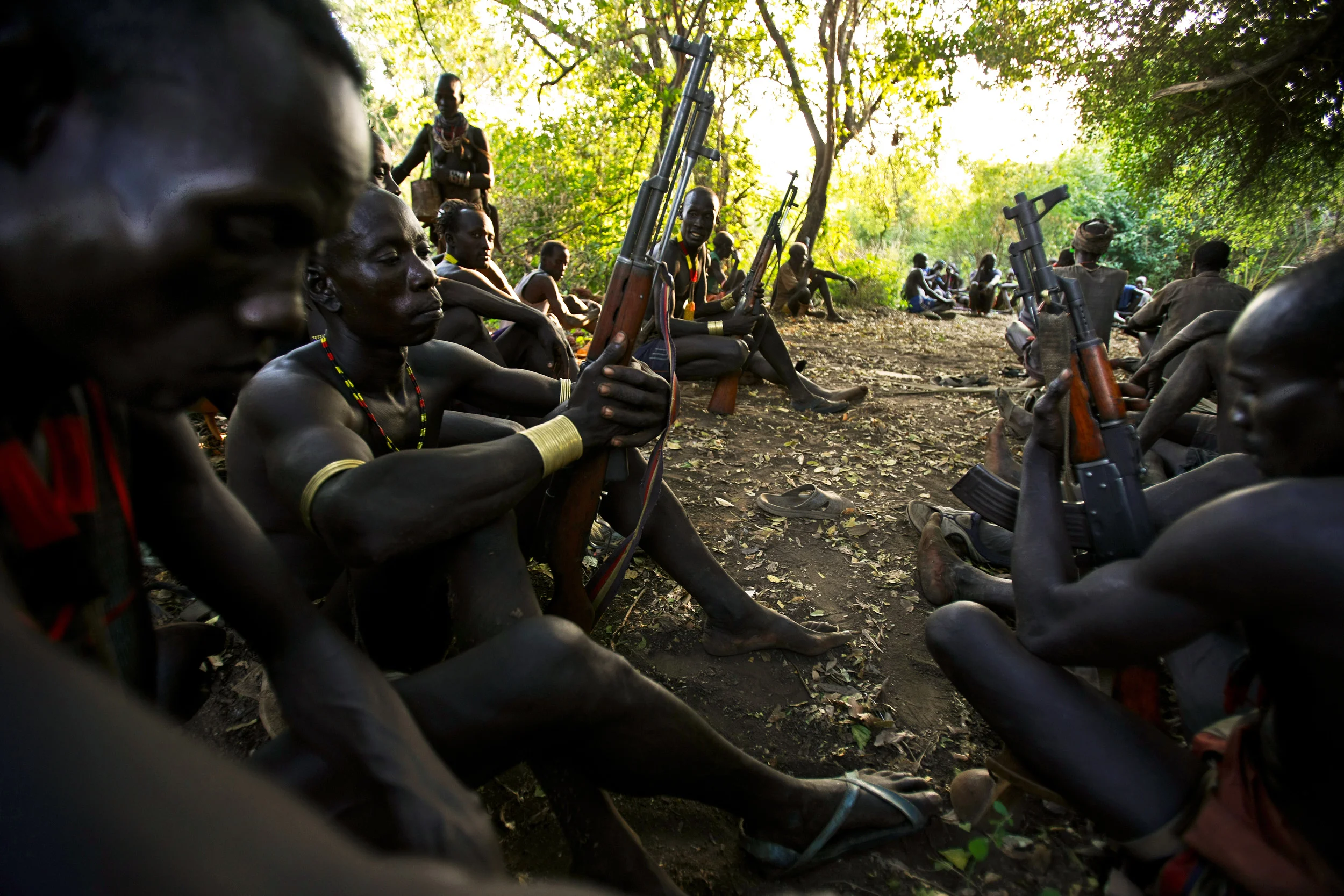
DUS, OMO VALLEY, ETHIOPIA, DECEMBER 2008: Images of armed Karo tribesman preparing for clashes with Bume people who have fired on them over a water rights dispute along the Omo river in the Omo Valley, South West Ethiopia, 14 December 2008. The Karo, with a population of about 1000,are a small group of people who live on the east banks of the Omo River. They are surrounded by relatively wealthy and strong groups,in terms of cattle and population size. The Omo river is severely threatened by the Gibe 3 dam project currently under construction by the Ethiopian government for hydro-electric purposes. There has been no environmental assesment study for the dam and it is likely to lower the Omo River level to one fifth of its current flow, thus removing the fertile flood plain utilised by the agro-pastoral tribes of the Omo Valley. The Omo River is also the chief tributary for Kenya's lake Turkana, just over the border, and thus the dam project is also likely to impact all the tribes living on Lake Turkana's shores and increase the conflicts over scarce agricultural and water resources. Karo, whose neighbors especially the Hamar (to the South East ) ,Bana (to the east ),Bashada (to the East ), the Mursi (to the North)and Nyangatom (to the west across the Omo river ) know them by the name Kara,speak a south Omotic language.The main subsistance crops of the Karo are sorghum ,maize and beans .They are supplemented by bee-keeping and more recently fishing.They plant fields using rain,flood retreat and river bank cultivation but the most important source of grain production is river bank farming than the other two which is carried out both along omo river and on the shores of Lake Diba.The Karo used to have big ,magnificient houses when they were rich in cattle but after they have lost their wealth through tsese fly they adopted the much lighter conical huts of the Bume.Every karo family own two houses-the conical shaped Ono which is the principal living room of the family an
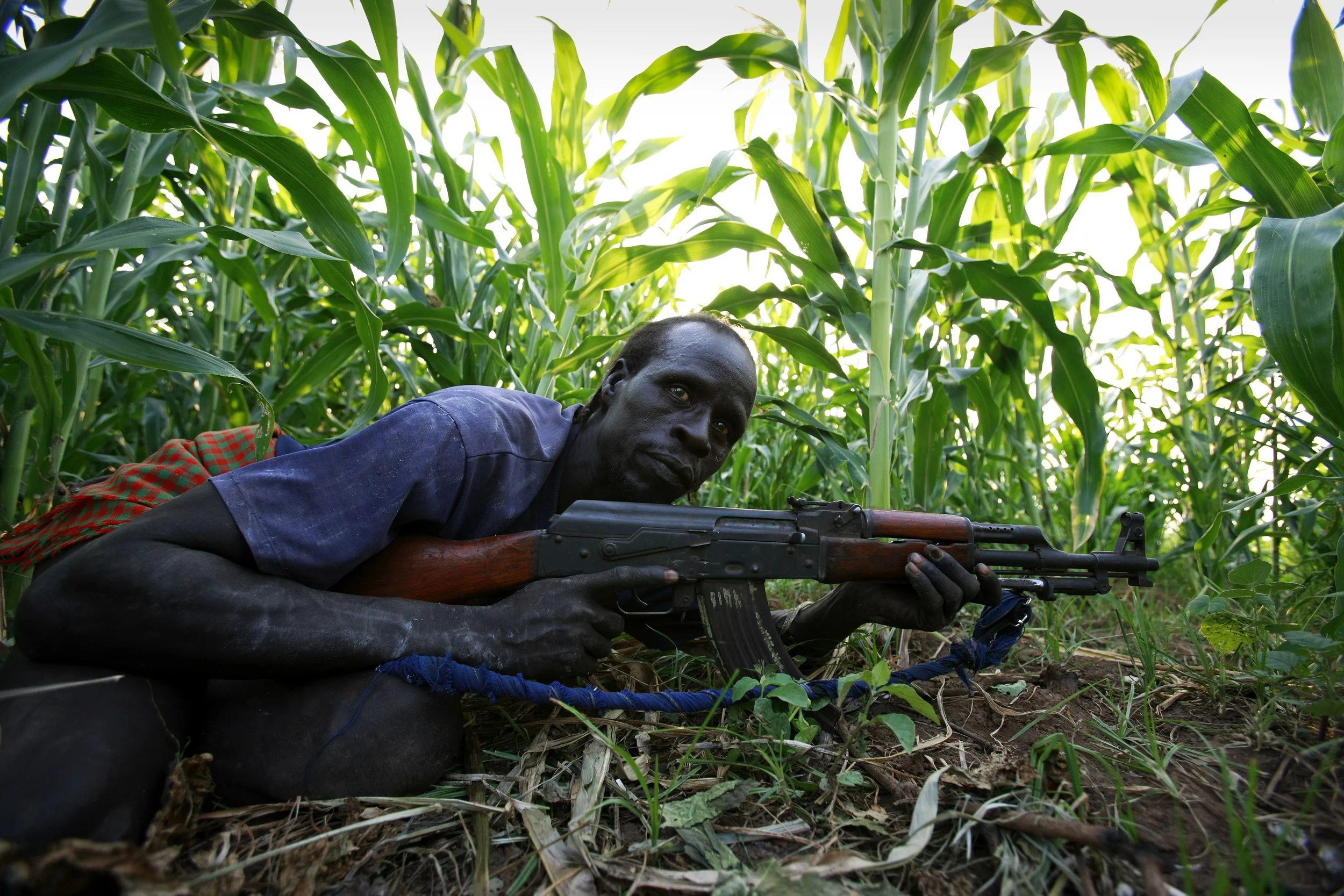
DUS, OMO VALLEY, ETHIOPIA, DECEMBER 2007: Images of a Karo tribesman clashing with Bume people who have fired on them over a water rights dispute in the Omo Valley, South West Ethiopia, 14 December 2007. The Karo, with a population of about 1000,are a small group of people who live on the east banks of the Omo River. They are surrounded by relatively wealthy and strong groups,in terms of cattle and population size. Karo, whose neighbors especially the Hamar (to the South East ) ,Bana (to the east ),Bashada (to the East ), the Mursi (to the North)and Nyangatom (to the west across the Omo river ) know them by the name Kara,speak a south Omotic language.The main subsistance crops of the Karo are sorghum ,maize and beans .They are supplemented by bee-keeping and more recently fishing.They plant fields using rain,flood retreat and river bank cultivation but the most important source of grain production is river bank farming than the other two which is carried out both along omo river and on the shores of Lake Diba.The Karo used to have big ,magnificient houses when they were rich in cattle but after they have lost their wealth through tsese fly they adopted the much lighter conical huts of the Bume.Every karo family own two houses-the conical shaped Ono which is the principal living room of the family and the flat roofed Gappa which is the center of several house hold activities.The Karo have Muldas- kind of gate having "Y" shaped wooden posts up on which are placed horizontal wooden pars.There are three settlements in Karo -Dus,Korcho and Labuk. The most striking thing about Karo people's symbolic and ornamental expressions is the painted body and face decorations. This is an elaborate process, which ranges from fine and elaborate details to rough, but striking paintings traced with the palms or fingers. The most beautiful expression is in the facial and chest paintings that combine white (chalk), black (charcoal), yellow, ochre, and red earth. They often imitate the sp




ORNGAYANET, NAROK SOUTH, KENYA, FEBRUARY 2010: Beatrice Chebkurui, one of two nurses in a local Masaai village, treats a Masaai child who has Malaria and Pneumonia in her small clinic in Orngayanet, 22 February, 2010, Kenya. This is a private practise and an average treatment costs around 500 Kenyan shillings, around $7. The main priorities of the Pastorilists around Kenya is access to medical treatment, education for their children and access to water for good grazing. The culture around cattle however means that selling them for money for these purposes is often a reluctant process. As land for grazing diminishes and drough and climate change and overpopulation loom, these practises will have to change if pastoralists are to move into a modern way of life. (Photo by Brent Stirton/Reportage by Getty Images.)


LAKE TURKANA, NORTHERN KENYA, MAY 2010: A mentally handicapped Dasenetch man, Michael, 20, in Lake Turkana North Kenya, 20 May 2010. A lack of any access to medical care resulted in brain damage when Michael was born. It remains an important priority for pastoralist tribes all over Kenya to have access to medical care in their communities in order to secure the well being of their people. The cost of this is driving many pastoralists to abandon traditional cattle practises and adopt other economic pursuits in order to cope with the pressures of their changing lives. (Photo by Brent Stirton/Reportage by Getty Images.)

LAKE TURKANA, NORTHERN KENYA, MAY 2010: A Belgian Catholic Priest is seen as Dasenetch pastoralists attend a church service at the local Catholic mission church in Ileret, North East Lake Turkana in North Kenya. The priest has been in the area for over 20 years and he and other priests like him have fundamentally changed the lives of many of the local pastoralists. The Dasenetch are moving slowly into a more modern way of thinking, with more focus on education and alternative livelihoods. The presence of various religous groups and churches has had a profound impact on the way that Pastoralists view themselves and their future, changing values and distancing them from many of their traditional ways. (Photo by Brent Stirton/Reportage by Getty Images.)
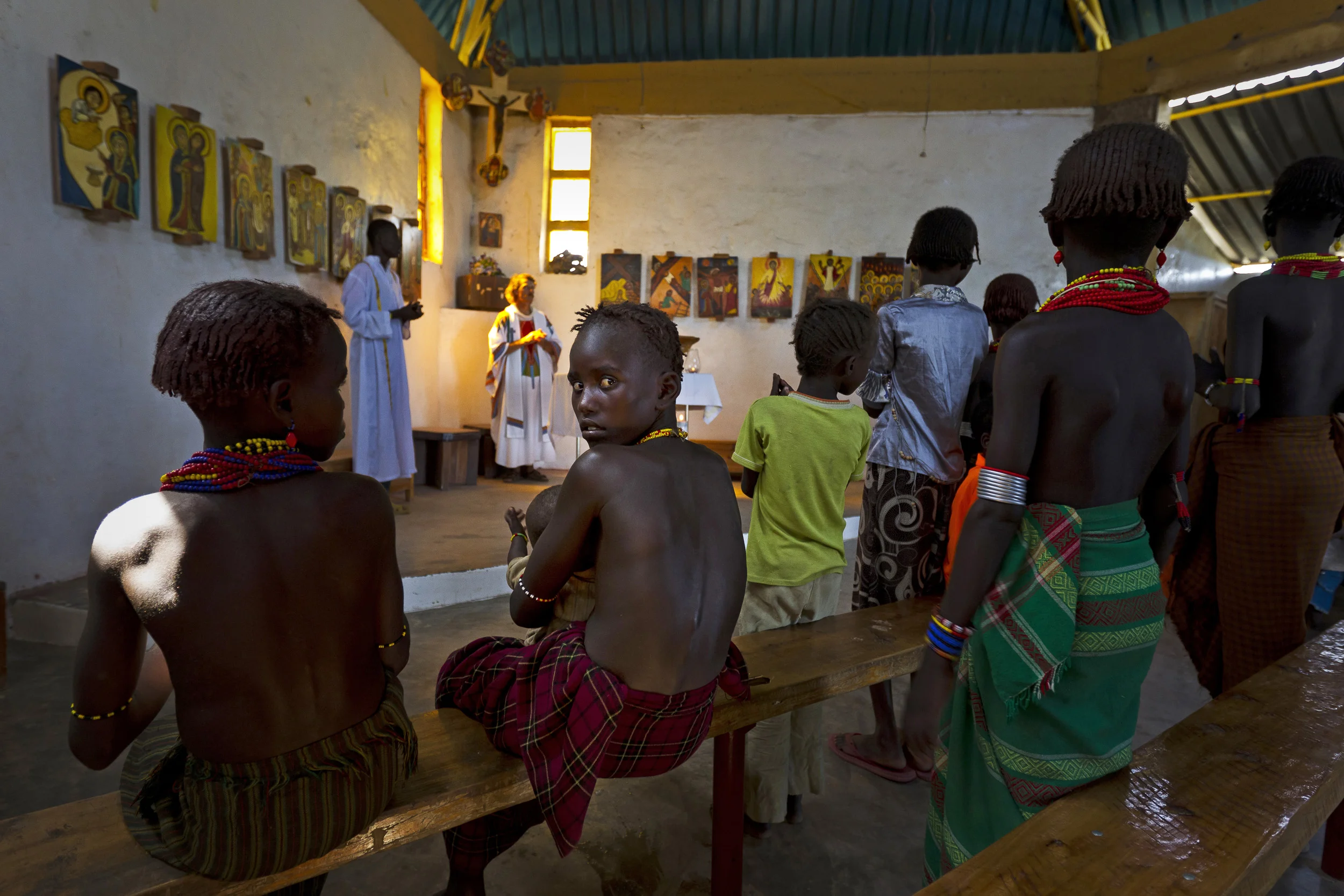
LAKE TURKANA, NORTHERN KENYA, MAY 2010: Dasenetch pastoralists attend a church service at the local Catholic mission church in Ileret, North East Lake Turkana in North Kenya, 20 May 2010. The Dasenetch are moving slowly into a more modern way of thinking, with more focus on education and alternative livelihoods. The presence of various religous groups and churches has had a profound impact on the way that Pastoralists view themselves and their future, changing values and distancing them from many of their traditional ways. (Photo by Brent Stirton/Reportage by Getty Images.)

LOWARENGAK, TURKANA, KENYA, 10 OCTOBER 2014: Three elder ladies who are members of "Legion of Mary" in Lowarengak, Turkana, Kenya. Relegion has had a profound effect on the Turkana pastoralists, changing the nature of their belief systems and in some cases, their way of life. (Photo by Brent Stirton/Reportage by Getty Images for HRW.)

OLDEREKESI RANCH, MASAAI MARA, FEBRUARY 2010: Masaai children at a boarding school for primary scholars, Olderekesi Ranch, Masaai Mara, Kenya, 19 February 2010. Education for their children, access to medical services and access to water are the three biggest pastoralist concerns today. The pastoralists across Kenya have found themselves at a tipping point, lack of land, overpopulation, pastoralist conflicts, the worst drought in over 100 years and huge subsequent cattle losses have driven the pastoralist tribes of Kenya to a point where change is becoming inevitable. The Masaai Mara has experienced tremendous exploitation by different tourist facilities which are not licensed and standardised. As a result there are too many illegal and unregulated lodges and this is having a drastic effect on the unique wildlife of Kenya as well on the pastoralists who no longer have enough land to maintain their nomadic cattle based lifestyle. (Photo by Brent Stirton/Reportage by Getty Images.)

ORNGAYANET, NAROK SOUTH, KENYA, FEBRUARY 2010: Images of a rural Masaai village school in Orngayanet area, Kenya, 22 February, 2010. The main priorities of the Pastorilists around Kenya is access to medical treatment, education for their children and access to water for good grazing. The culture around cattle however means that selling them for money for these purposes is often a reluctant process. As land for grazing diminishes and drough and climate change and overpopulation loom, these practises will have to change if pastoralists are to move into a modern way of life. (Photo by Brent Stirton/Reportage by Getty Images.)

KALOKOL, TURKANA, KENYA, 8 OCTOBER 2014: Scenes from Kalokol Girls Primary school where girls do not have access to running water. The girls take it in turns to fetch water daily from a dry river source which sees them exposed to potential danger and taking time off from their studies to walk the two hour round trip it takes them to fetch water. (Photo by Brent Stirton/Reportage by Getty Images for HRW. )

KALOKOL, TURKANA, KENYA, 8 OCTOBER 2014: Girls study in the dormitory at the Kalokol Girls Primary school where girls do not have access to running water. The girls take it in turns to fetch water daily from a dry river source which sees them exposed to potential danger and taking time off from their studies to walk the two hour round trip it takes them to fetch water. (Photo by Brent Stirton/Reportage by Getty Images for HRW. )

ILERET, LAKE TURKANA, NORTHERN KENYA, MAY 2010: A Dasenetch pastoralist school in the Ileret district, Lake Turkana, North Kenya, 21 May 2010. Education is new for the Dasenetch and has been embraced over the last 20 years. It is primarily focused on boys, with only one girl in each of the senior classes at Ileret Primary school. This has to do with gender bias, early marriage and bride price. The Dasenetch are still coming to terms with the long term value of education for girls, who are 90% proven to return to their communities with their education and bring value to the community. Boys on the other hand are statistically 90% likely to move to larger centres and thus further erode the traditional way of life of these pastoralist people. There is also very little subsidy for children going on to high school, it costs in the region of $2000 to put a child through high school in Kenya and this is way beyond the financial reach of most pastoralist families. Thus, although their traditional lives are being eroded by globalisation, overpopulation, climate change and other factors, the Dasenetch and other pastoralist groups find themselves ill prepared in terms of education to cope with the transistion in their culture. (Photo by Brent Stirton/Reportage by Getty Images.)
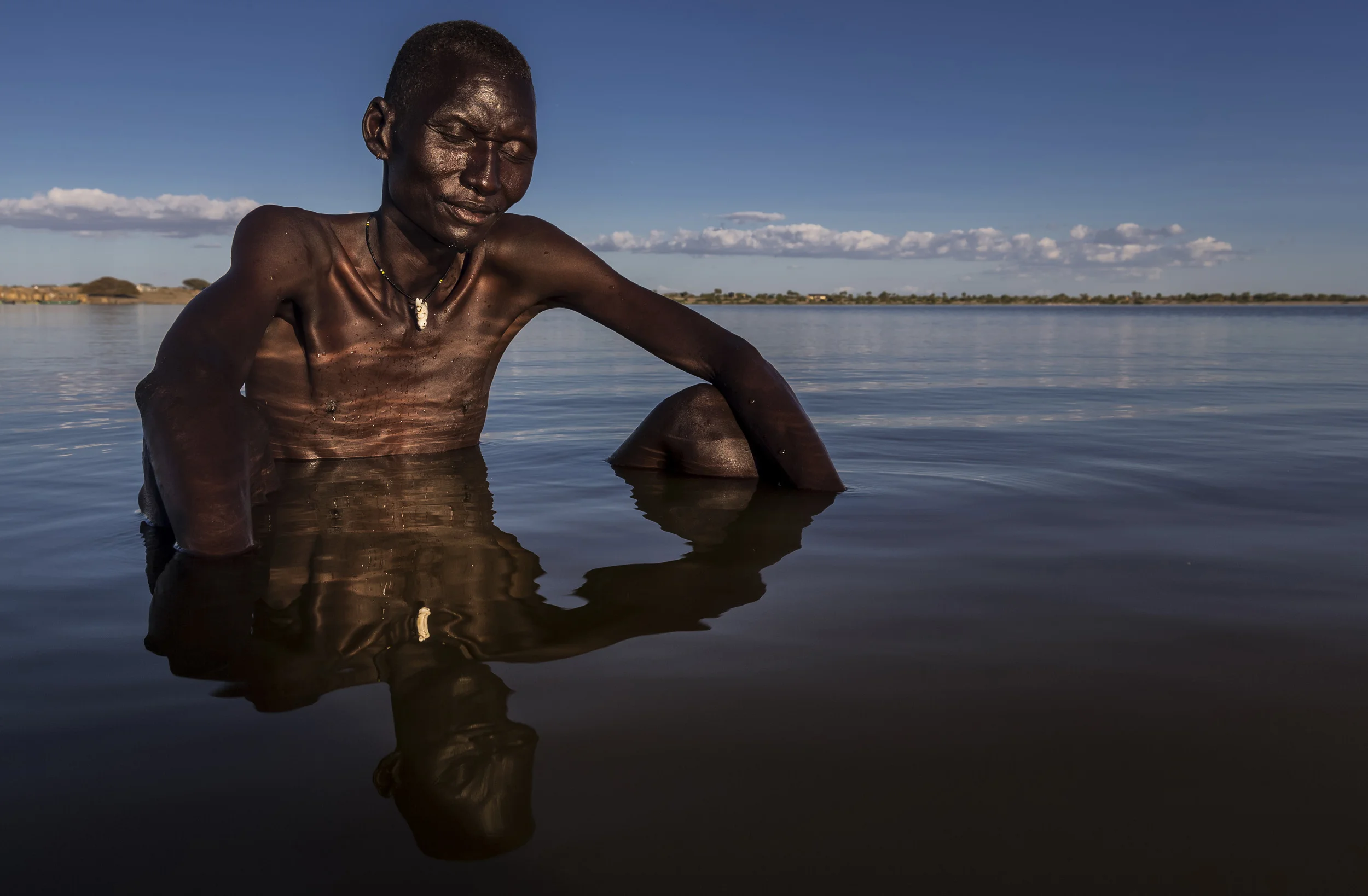
TURKANA, KENYA, 8 OCTOBER 2014: Scenes from Longetch fishing village on the shores of Lake Turkana, Kenya, the world's largest inland desert lake. This region of the lake is a well know spawning ground and at the heart of fishing commerce for the Turkana. These villagers along with many thousands along the shores of this vast body of water are soley dependent on the lake for their survival. The Turkana are traditionally pastoralists but persistent droughts have decimated their herds to such an extent that for many Turkana fishing is now their main means of subsistence and commerce. The same pattern is emerging for other tribes along the lake shore. Recent dam building in Ethiopia is likely to bring the Omo river to one fifth of its current flow, sugar cane farms along the Omo are already causing tribal movement down to Lake Turkana as pastoralists struggle for grazing and water rights. The Omo river supplies 90% of Lake Turkana's water and these dams and sugar cane farms look likely to severly impact the renewal of the lake's waters. This threatens all the tribes around the lake and makes conflict over diminishing resources ever likely. (Photo by Brent Stirton/Reportage by Getty Images for Human Rights Watch.)
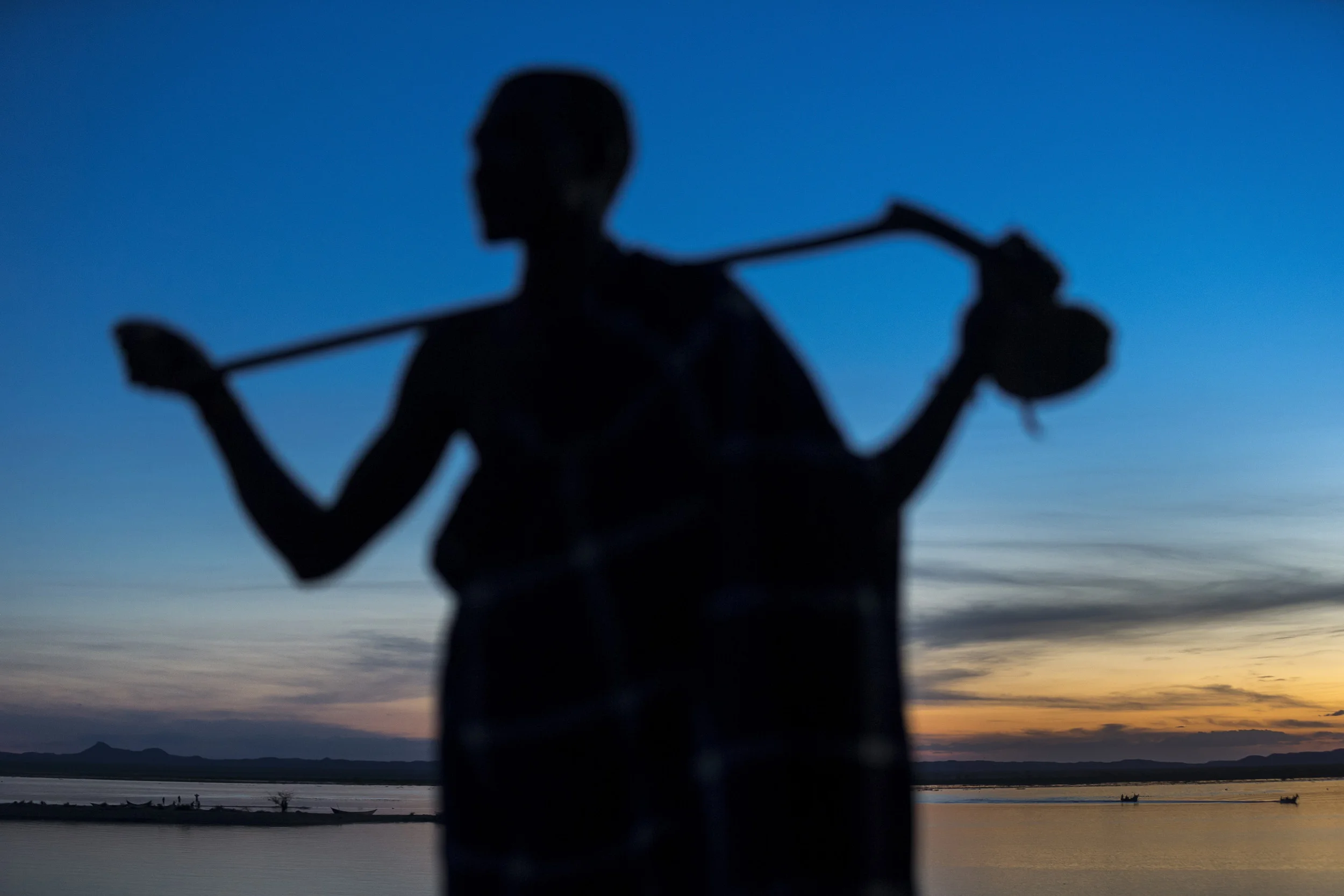
TURKANA, KENYA, 8 OCTOBER 2014: Scenes from Longetch fishing village on the shores of Lake Turkana, Kenya, the world's largest inland desert lake. This region of the lake is a well know spawning ground and at the heart of fishing commerce for the Turkana. These villagers along with many thousands along the shores of this vast body of water are soley dependent on the lake for their survival. The Turkana are traditionally pastoralists but persistent droughts have decimated their herds to such an extent that for many Turkana fishing is now their main means of subsistence and commerce. The same pattern is emerging for other tribes along the lake shore. Recent dam building in Ethiopia is likely to bring the Omo river to one fifth of its current flow, sugar cane farms along the Omo are already causing tribal movement down to Lake Turkana as pastoralists struggle for grazing and water rights. The Omo river supplies 90% of Lake Turkana's water and these dams and sugar cane farms look likely to severly impact the renewal of the lake's waters. This threatens all the tribes around the lake and makes conflict over diminishing resources ever likely. (Photo by Brent Stirton/Reportage by Getty Images for Human Rights Watch.)
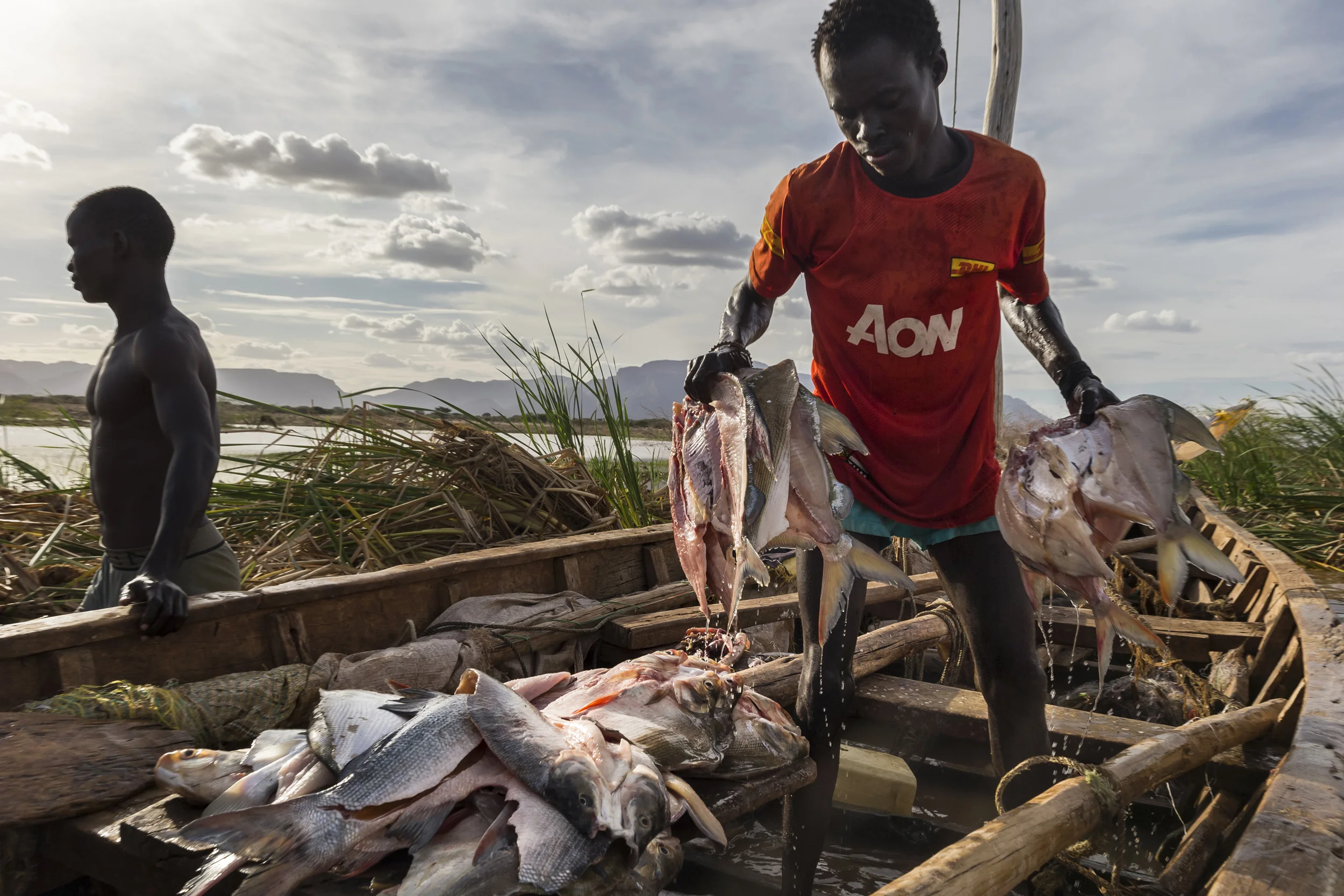
LOWARENGAK, TURKANA, KENYA, 10 OCTOBER 2014: Images from an internally displaced Turkana community who have been moved off their land by Dassanech tribesman who raided their cattle and killed their people, Turkana, Kenya. These Turkana now practise fishing as opposed to their traditional pastoralism as their main means of subsistence. The Dassenech have in fact come illegally over the Ethiopian border into Turkana land. They were pressured by sugar cane farms on the lower Omo river which is the main tributary for Lake Turkana, the largest desert lake in the world. These sugar cane farms robbed the Dassenech of tradional grazing land and water rights and so they moved over the border into Turkana territory and ongoing conflict is the result. This pattern is likely to increase as Ethiopia's Gibe 3 dam comes online next year. This will reduce the flow of the Omo river to one fifth of its current size. This will decimate the fertile flood plain in the region and the tribesmen along the Omo will fight for diminishing resources as a result. This conflict will be likely to continue in Kenya's Turkana region as all around the lake hundreds of thousands of tribespeople will find themselves competing for less and grazing, fishing and clean water sources. A series of droughts have reduced most of these pastoralists to fishing as their chief source of subsistence due to huge cattle and goat deaths. The massively reduced flow of the Omo, source of 90% of Lake Turkana's water, could have a devastating effect on this food and income source. The Ethiopian government has conducted no Environmental Impact Assessment for their dams and has yet to respond to these issues. (Photo by Brent Stirton/Reportage by Getty Images for HRW.)
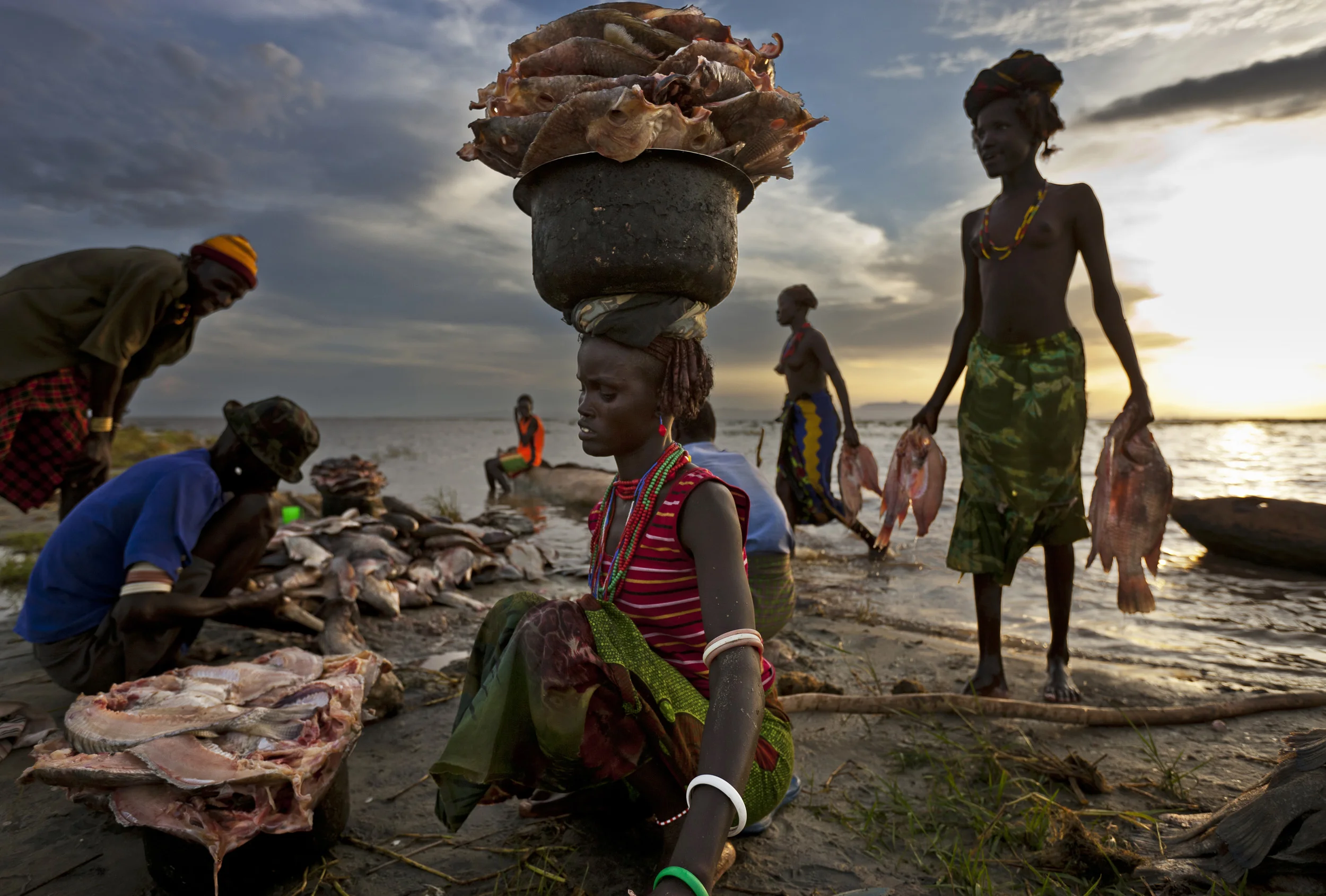
LAKE TURKANA, NORTHERN KENYA, MAY 2010: Dasenetch pastoralist people with their catch of Tilapia fish in Lake Turkana in North Kenya, 20 May 2010. Fishing is a relatively new phenomenon for the Dasenetch, drought and climate change have forced them to look further than cattle for alternative sources of sustenance and economy. Fishing has become the primary means in the Lake Turkana region but has yet to reach any real commercial significance. The lake is the largest desert lake in the world and sustains both Turkana and Dasenetch people as well as Gabra and other tribes in the region. Lake Turkana faces an uncertain future however as the Gibe 3 dam project in Ethiopia, a massive hydro-electric scheme and Ethiopia's biggest single investment, comes on line. The dam project, designed to create electricity for sale to surrounding countries including Kenya, will reduce the flow of the Omo river dramatically and this river is the main feeder river for Lake Turkana. Significant changes in lake levels and in ecology can be expected as a result. Fertile flood plain invaluable for agriculture will also be negatively impacted. All of this bodes badly for the pastoralists of the Lake Turkana and Southern Ethiopia's Omo river region, these groups are already under severe subsistence pressure and there is a long history of armed conflict in the region. Weapons flow in to this region through Sudan and Somalia and there is little control over this trade which looks likely to accelerate if pressures increase in this region. At this time the Dam project has full support from Kenya's Nairobi government, despite the fact that there has been no Environmental Impact Asssesment produced for this scheme. (Photo by Brent Stirton/Reportage by Getty Images.)

TURKANA, KENYA, 8 OCTOBER 2014: Scenes from Longetch fishing village on the shores of Lake Turkana, Kenya, the world's largest inland desert lake. This region of the lake is a well know spawning ground and at the heart of fishing commerce for the Turkana. These villagers along with many thousands along the shores of this vast body of water are soley dependent on the lake for their survival. The Turkana are traditionally pastoralists but persistent droughts have decimated their herds to such an extent that for many Turkana fishing is now their main means of subsistence and commerce. The same pattern is emerging for other tribes along the lake shore. Recent dam building in Ethiopia is likely to bring the Omo river to one fifth of its current flow, sugar cane farms along the Omo are already causing tribal movement down to Lake Turkana as pastoralists struggle for grazing and water rights. The Omo river supplies 90% of Lake Turkana's water and these dams and sugar cane farms look likely to severly impact the renewal of the lake's waters. This threatens all the tribes around the lake and makes conflict over diminishing resources ever likely. (Photo by Brent Stirton/Reportage by Getty Images for Human Rights Watch.)

TURKANA, KENYA, 8 OCTOBER 2014: Scenes from Longetch fishing village on the shores of Lake Turkana, Kenya, the world's largest inland desert lake. This region of the lake is a well know spawning ground and at the heart of fishing commerce for the Turkana. These villagers along with many thousands along the shores of this vast body of water are soley dependent on the lake for their survival. The Turkana are traditionally pastoralists but persistent droughts have decimated their herds to such an extent that for many Turkana fishing is now their main means of subsistence and commerce. The same pattern is emerging for other tribes along the lake shore. Recent dam building in Ethiopia is likely to bring the Omo river to one fifth of its current flow, sugar cane farms along the Omo are already causing tribal movement down to Lake Turkana as pastoralists struggle for grazing and water rights. The Omo river supplies 90% of Lake Turkana's water and these dams and sugar cane farms look likely to severly impact the renewal of the lake's waters. This threatens all the tribes around the lake and makes conflict over diminishing resources ever likely. (Photo by Brent Stirton/Reportage by Getty Images for Human Rights Watch.)

TURKANA, KENYA, 8 OCTOBER 2014: Scenes from Longetch fishing village on the shores of Lake Turkana, Kenya, the world's largest inland desert lake. This region of the lake is a well know spawning ground and at the heart of fishing commerce for the Turkana. These villagers along with many thousands along the shores of this vast body of water are soley dependent on the lake for their survival. The Turkana are traditionally pastoralists but persistent droughts have decimated their herds to such an extent that for many Turkana fishing is now their main means of subsistence and commerce. The same pattern is emerging for other tribes along the lake shore. Recent dam building in Ethiopia is likely to bring the Omo river to one fifth of its current flow, sugar cane farms along the Omo are already causing tribal movement down to Lake Turkana as pastoralists struggle for grazing and water rights. The Omo river supplies 90% of Lake Turkana's water and these dams and sugar cane farms look likely to severly impact the renewal of the lake's waters. This threatens all the tribes around the lake and makes conflict over diminishing resources ever likely. (Photo by Brent Stirton/Reportage by Getty Images for Human Rights Watch.)

LAISAMIS, MARSABIT SOUTH, NORTH KENYA: Rendille women collect water from a well at the new Manyata Koya, a relocated village which moved 42 kilometers from the original Koya in 1992 due to heavy cattle raiding and fighting with the Borana tribe, North of Kenya, 27 February 2010. North Kenya is currently undergoing an intense disarmament process in which the Kenyan Army and Administrative Police are trying to disarm the local tribes, mainly the Borana, the Samburu, the Rendille and Somalis, amongst others. This process is controversial as the tribes feel they have to have weapons to protect against cattle raids from the other tribes. This is an age old conflict but the Rendille and Samburu feel especially vulnerable as the Borana exist on both sides of the border region with Kenya and can thus access weapons from their fellow tribesmen on the Ethiopian side. This is also true of the Somalis and as such the Rendille and Samburu feel especially vulnerable. Although weapons have been collected there are many stories of violence by the Kenyan authorities against the tribes in this process, especially against the Samburu and the Rendille. This process has not been helped by the fact that many of the biggest cattle raids in history have been made by the Borana against the Rendille and Samburu in the last year. It looks unlikely that of the 23 000 weapons allegedly in the field only a few hundred have thus far been collected. (Photo by Brent Stirton/ Reportage by Getty Images.)
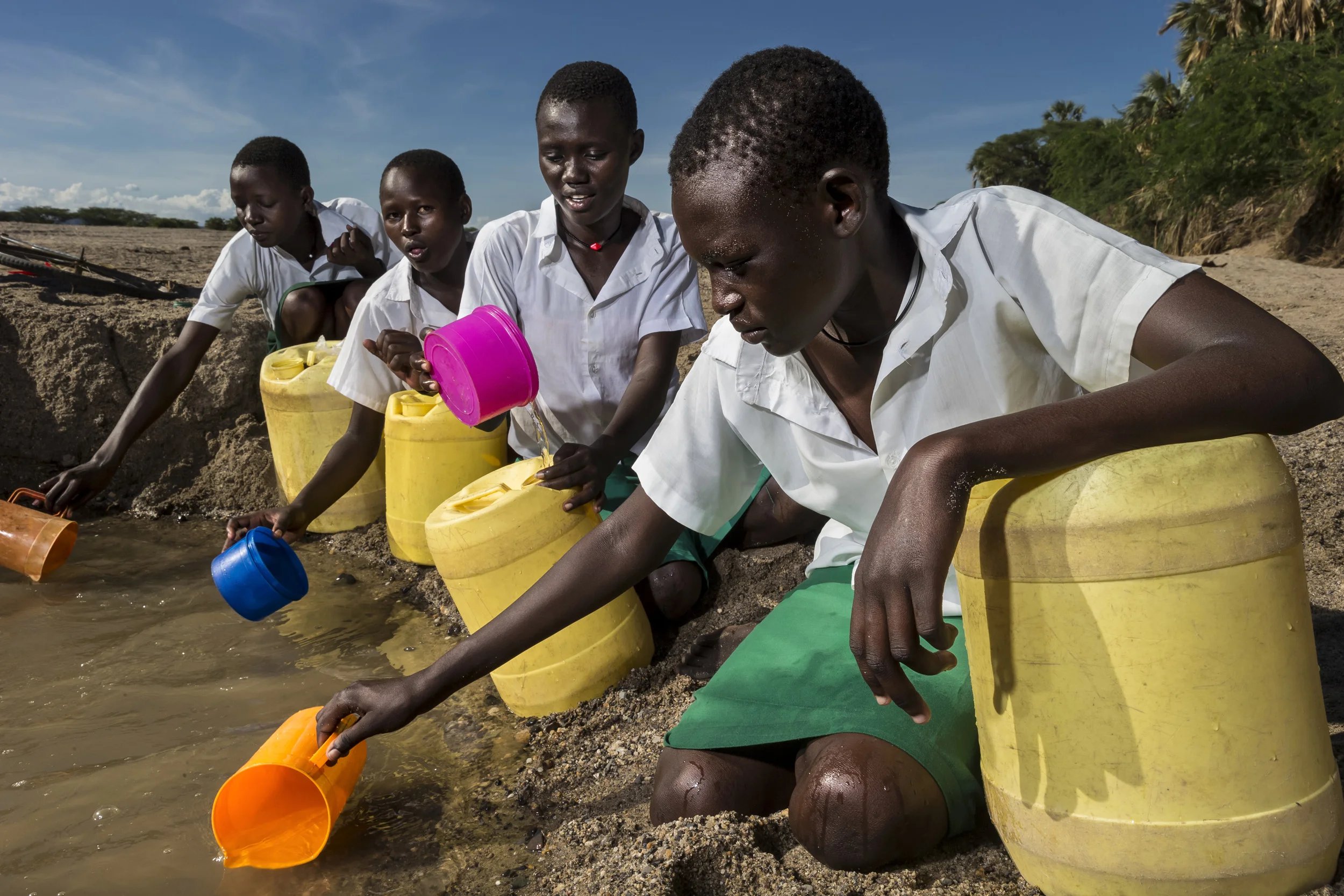
KALOKOL, TURKANA, KENYA, 8 OCTOBER 2014: Girls from Kalokol Girls Primary school collect water from a dry river bed as their school does do not have access to running water. The girls take it in turns to fetch water daily from a dry river source which sees them exposed to potential danger and taking time off from their studies to walk the two hour round trip it takes them to fetch water. (Photo by Brent Stirton/Reportage by Getty Images for HRW. )
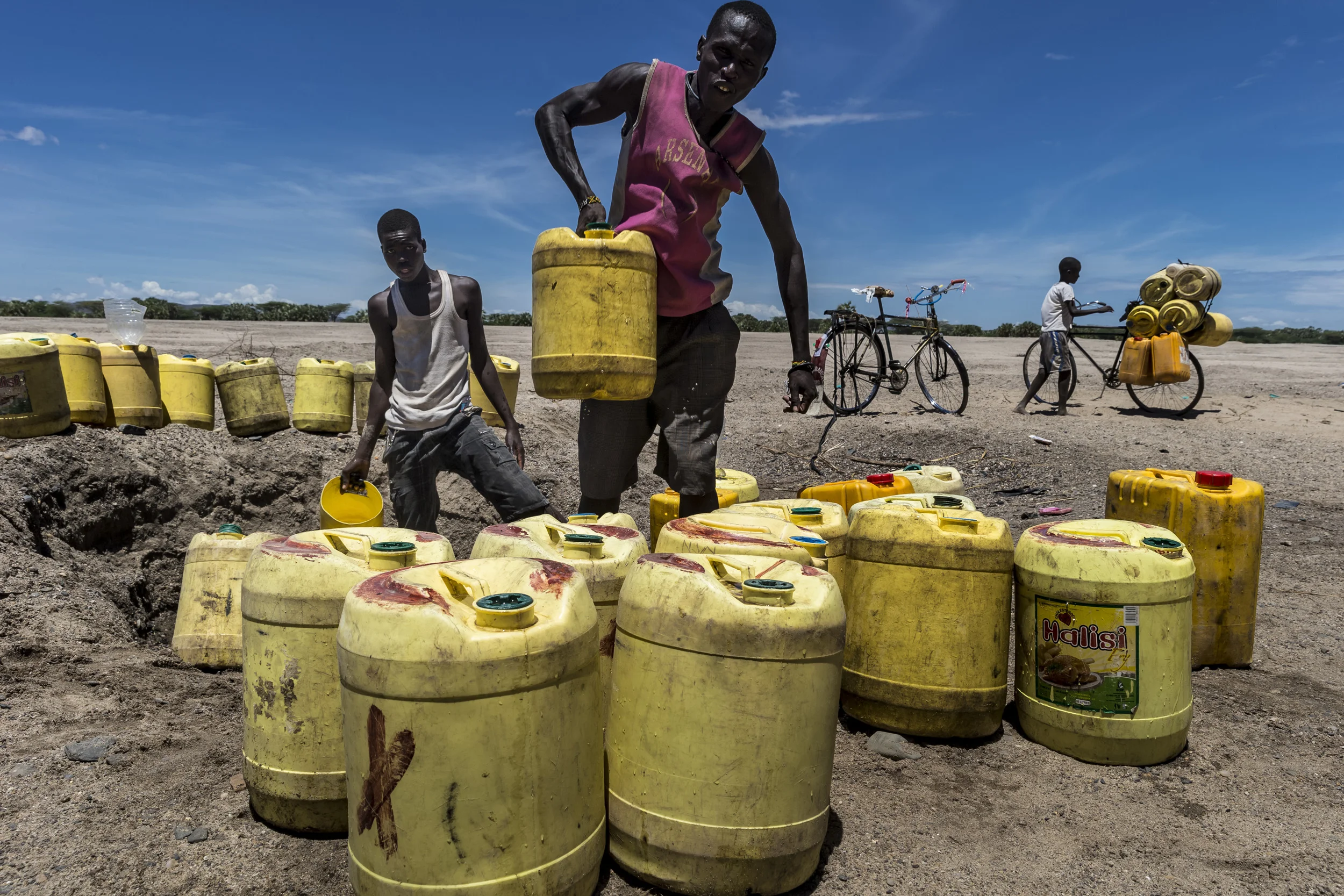
TURKANA, KENYA, 8 OCTOBER 2014: Boys collect water from a dry river bed to sell it in the nearby town of Karokol, Lake Turkana, Kenya. The water is sold for around 20 Kenyan Shillings for 20 Gallons. The town does not have running water and most water is sourced this way. (Photo by Brent Stirton/Reportage by Getty Images for HRW.)

RIFT VALLEY PROVINCE, KENYA, NOVEMBER 2009: Large flower hothouses close to Mount Kenya which form Kenya's current most important export, North Kenya. These hothouses take an estimated 95% of the water flow of the Ewaso Nyiro river, the only major river in the north of Kenya at a time of the worst drought in Kenya for the last 100 years, 20 November 2009. The drought has brought about increasingly deadly conflict between pastoralists as well as conservationists all competing for grazing land and the small amount of available water. (Photo by Brent Stirton/Reportage by Getty Images.)

LOWARENGAK, TURKANA, KENYA, 10 OCTOBER 2014: Images from an internally displaced Turkana community who have been moved off their land by Dassanech tribesman who raided their cattle and killed their people, Turkana, Kenya. These Turkana now practise fishing as opposed to their traditional pastoralism as their main means of subsistence. The Dassenech have in fact come illegally over the Ethiopian border into Turkana land. They were pressured by sugar cane farms on the lower Omo river which is the main tributary for Lake Turkana, the largest desert lake in the world. These sugar cane farms robbed the Dassenech of tradional grazing land and water rights and so they moved over the border into Turkana territory and ongoing conflict is the result. This pattern is likely to increase as Ethiopia's Gibe 3 dam comes online next year. This will reduce the flow of the Omo river to one fifth of its current size. This will decimate the fertile flood plain in the region and the tribesmen along the Omo will fight for diminishing resources as a result. This conflict will be likely to continue in Kenya's Turkana region as all around the lake hundreds of thousands of tribespeople will find themselves competing for less and grazing, fishing and clean water sources. A series of droughts have reduced most of these pastoralists to fishing as their chief source of subsistence due to huge cattle and goat deaths. The massively reduced flow of the Omo, source of 90% of Lake Turkana's water, could have a devastating effect on this food and income source. The Ethiopian government has conducted no Environmental Impact Assessment for their dams and has yet to respond to these issues. (Photo by Brent Stirton/Reportage by Getty Images for HRW.)

LOWARENGAK, TURKANA, KENYA, 10 OCTOBER 2014: Images from an internally displaced Turkana community who have been moved off their land by Dassanech tribesman who raided their cattle and killed their people, Turkana, Kenya. These Turkana now practise fishing as opposed to their traditional pastoralism as their main means of subsistence. The Dassenech have in fact come illegally over the Ethiopian border into Turkana land. They were pressured by sugar cane farms on the lower Omo river which is the main tributary for Lake Turkana, the largest desert lake in the world. These sugar cane farms robbed the Dassenech of tradional grazing land and water rights and so they moved over the border into Turkana territory and ongoing conflict is the result. This pattern is likely to increase as Ethiopia's Gibe 3 dam comes online next year. This will reduce the flow of the Omo river to one fifth of its current size. This will decimate the fertile flood plain in the region and the tribesmen along the Omo will fight for diminishing resources as a result. This conflict will be likely to continue in Kenya's Turkana region as all around the lake hundreds of thousands of tribespeople will find themselves competing for less and grazing, fishing and clean water sources. A series of droughts have reduced most of these pastoralists to fishing as their chief source of subsistence due to huge cattle and goat deaths. The massively reduced flow of the Omo, source of 90% of Lake Turkana's water, could have a devastating effect on this food and income source. The Ethiopian government has conducted no Environmental Impact Assessment for their dams and has yet to respond to these issues. (Photo by Brent Stirton/Reportage by Getty Images for HRW.)

LOWARENGAK, TURKANA, KENYA, 10 OCTOBER 2014: Images from an internally displaced Turkana community who have been moved off their land by Dassanech tribesman who raided their cattle and killed their people, Turkana, Kenya. These Turkana now practise fishing as opposed to their traditional pastoralism as their main means of subsistence. The Dassenech have in fact come illegally over the Ethiopian border into Turkana land. They were pressured by sugar cane farms on the lower Omo river which is the main tributary for Lake Turkana, the largest desert lake in the world. These sugar cane farms robbed the Dassenech of tradional grazing land and water rights and so they moved over the border into Turkana territory and ongoing conflict is the result. This pattern is likely to increase as Ethiopia's Gibe 3 dam comes online next year. This will reduce the flow of the Omo river to one fifth of its current size. This will decimate the fertile flood plain in the region and the tribesmen along the Omo will fight for diminishing resources as a result. This conflict will be likely to continue in Kenya's Turkana region as all around the lake hundreds of thousands of tribespeople will find themselves competing for less and grazing, fishing and clean water sources. A series of droughts have reduced most of these pastoralists to fishing as their chief source of subsistence due to huge cattle and goat deaths. The massively reduced flow of the Omo, source of 90% of Lake Turkana's water, could have a devastating effect on this food and income source. The Ethiopian government has conducted no Environmental Impact Assessment for their dams and has yet to respond to these issues. (Photo by Brent Stirton/Reportage by Getty Images for HRW.)

LOWARENGAK, TURKANA, KENYA, 10 OCTOBER 2014: Village defence man Steven Lajore, 27, is from an internally displaced Turkana community who have been moved off their land by Dassanech tribesman who raided their cattle and killed their people, Turkana, Kenya. These Turkana now practise fishing as opposed to their traditional pastoralism as their main means of subsistence. Steven is seen guarding the boats from Dassanech raids. The Dassenech have in fact come illegally over the Ethiopian border into Turkana land. They were pressured by sugar cane farms on the lower Omo river which is the main tributary for Lake Turkana, the largest desert lake in the world. These sugar cane farms robbed the Dassenech of tradional grazing land and water rights and so they moved over the border into Turkana territory and ongoing conflict is the result. This pattern is likely to increase as Ethiopia's Gibe 3 dam comes online next year. This will reduce the flow of the Omo river to one fifth of its current size. This will decimate the fertile flood plain in the region and the tribesmen along the Omo will fight for diminishing resources as a result. This conflict will be likely to continue in Kenya's Turkana region as all around the lake hundreds of thousands of tribespeople will find themselves competing for less and grazing, fishing and clean water sources. A series of droughts have reduced most of these pastoralists to fishing as their chief source of subsistence due to huge cattle and goat deaths. The massively reduced flow of the Omo, source of 90% of Lake Turkana's water, could have a devastating effect on this food and income source. The Ethiopian government has conducted no Environmental Impact Assessment for their dams and has yet to respond to these issues. (Photo by Brent Stirton/Reportage by Getty Images for HRW.)

OLDEREKESI RANCH, MASAAI MARA, FEBRUARY 2010: An age group of Olderekesi community elected Masaai elders discuss the pros and cons of turning away for cattle pastoralism towards wildlife conservation as a primary income source, Olderekesi Ranch, Masaai Mara, Kenya, 19 February 2010. This group is meeting with Calvin Cottar, a white Kenyan who is attempting to deal with the Masaai on this land where he has a safari camp in which he wants to be involved with the local Masaai. If the land is privatised and the Masaai decide to go the wildlife conservation route they will make a guaranteed income from it through Calvin Cottar and other Safari camps on the leased Masaai land. The pastoralists across Kenya have found themselves at a tipping point, lack of land, overpopulation, pastoralist conflicts, the worst drought in over 100 years and huge subsequent cattle losses have driven the pastoralist tribes of Kenya to a point where change is becoming inevitable. The Masaai Mara has experienced tremendous exploitation by different tourist facilities which are not licensed and standardised. As a result there are too many illegal and unregulated lodges and this is having a drastic effect on the unique wildlife of Kenya as well on the pastoralists who no longer have enough land to maintain their nomadic cattle based lifestyle. (Photo by Brent Stirton/Reportage by Getty Images.)
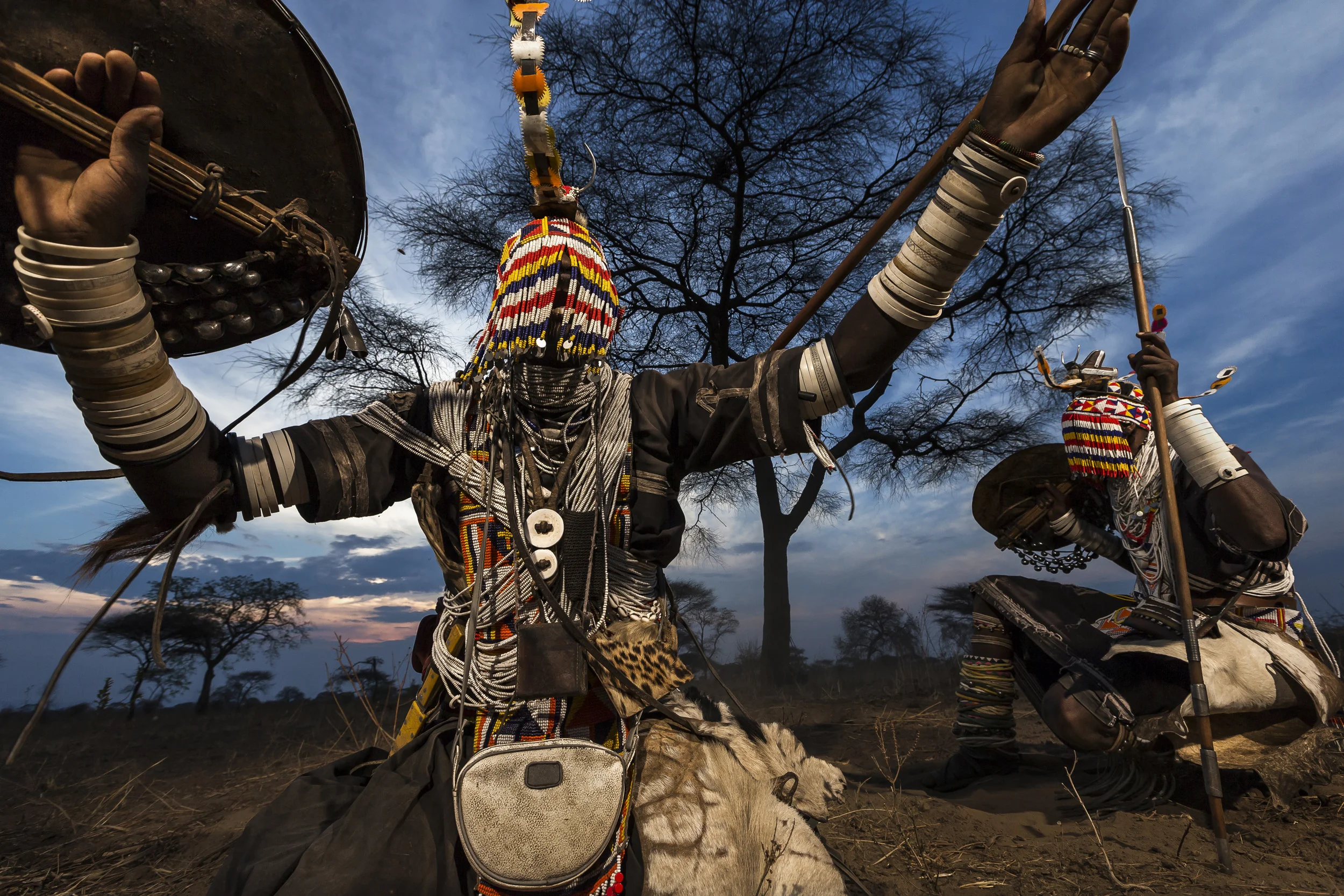
MPIMBWE, WESTERN TANZANIA, OCTOBER 2012: Lion Dancers from the Sakuma tribe perform the story of their lion killing outside a village in rural Mpimbwe, Western Tanzania, October 27, 2012. Lion dancers are men who have killed a lion in defense of their cattle or their village. They are a deeply superstitious people who believe that once they have killed a lion they have to become a lion dancer for 3 to 5 years to avoid going mad. They spend a year or longer preparing with the local witchdoctor and then go from village to village seeing their relatives and dancing while collecting tribute for their bravery. In a time when lion are very scarce in the region, this practice is actively discouraged by conservation organizations and it is slowly dying out. When the dancers appear in the villages, they are often praised and given money, goats and even sometimes a small cow. It is therefore something that some young men aspire to, even going as far as to venture into the local Katavi National Park in pursuit of a lion. (Photo by Brent Stirton/Reportage for National Geographic Magazine.)


MASAAI MARA NATIONAL RESERVE, KENYA, FEBRUARY 2010. Kenyan men who are former pastoralists now working for an early morning ballon ride service inside the Masaai Mara National Reserve, Kenya, 25 February 2010. Pastoralist throughout Kenya are in transistion, affected by land pressures, drought, insecurity and competition for grazing lands, many are turning towards Kenya's conservation and tourist industry for security and income. Some of that is manifesting in land leasing by various tribes to tourism operators, others are working directly in tourism in the game parks like these three men who are chefs at Governor's Camp in the Masaai Mara Nature conservancy reserve. (Photo by Brent Stirton/Reportage by Getty Images)

MASAAI MARA NATIONAL RESERVE, KENYA, FEBRUARY 2010. Samson Lenjirr, 41, the AG Chief Game Warden of the Mara Triangle Conservancy Masaai Mara National Reserve, Kenya. Lenjirr has been an outspoken critic of the abundance of illegal safari lodges, camps and hotels in the reserve. He has campaigned for a proper land management plan from the Kenyan Government and spoken out fearlessly about corruption and the resulting overcrowding and ecologically unsound practises happening in the Mara today. There are currently 108 tourist operations in the greater Mara area, of which only 29% meet the legal standards to be in business. Lenjirr believes that unless something is done soon, the Mara will reach a tipping point from which there can be no return for arguably the most important wildlife reserve in the world. (Photo by Brent Stirton/Reportage by Getty Images)
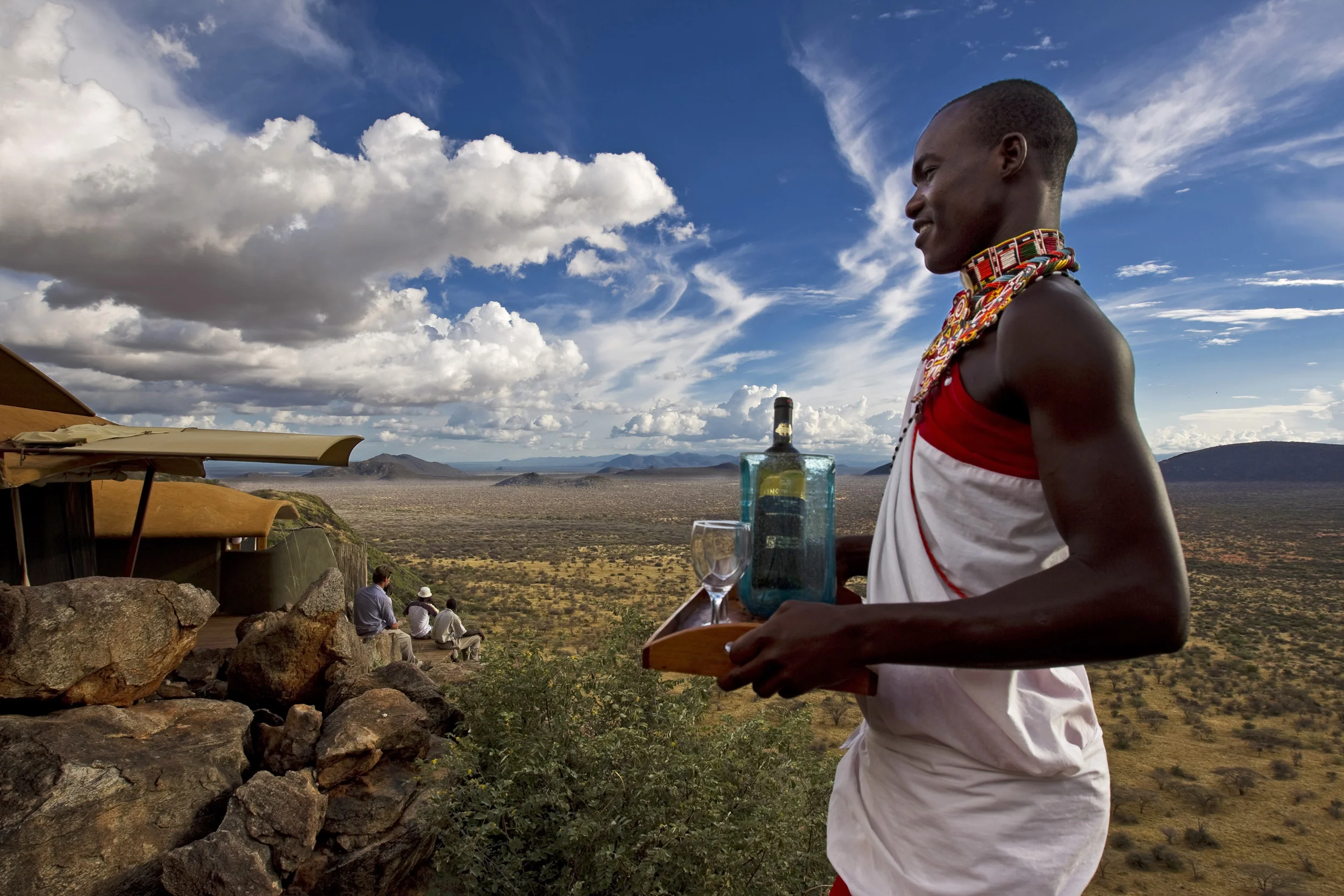
KALAMA CONSERVANCY, ISIOLO DISTRICT, NORTH KENYA: Scenes of local Samburu men from the Kalama Conservancy working at exclusive Saruni Lodge in Northern Kenya, 1 March 2010. The lodge has been in existence for two years, the conservancy for six. It is an example of a local community conservancy working with and advocating for viable tourism in an area which previously would have only been used for cattle grazing. In the two years that Saruni has been built, there has been a substantial return of wildlife to the area and the local Kalama community have derived an annual land lease and Park fee payment which has substantially reinforced their commitment to conservation and tourism alongside sustainable pastoralism. All of this has been with the advice and educational training of the Northern Rangeland Trust, an NGO specialising in sustainable pastoralism and wildlife conservation in local communities in the North of Kenya. (Photo by Brent Stirton/ Reportage by Getty Images.)
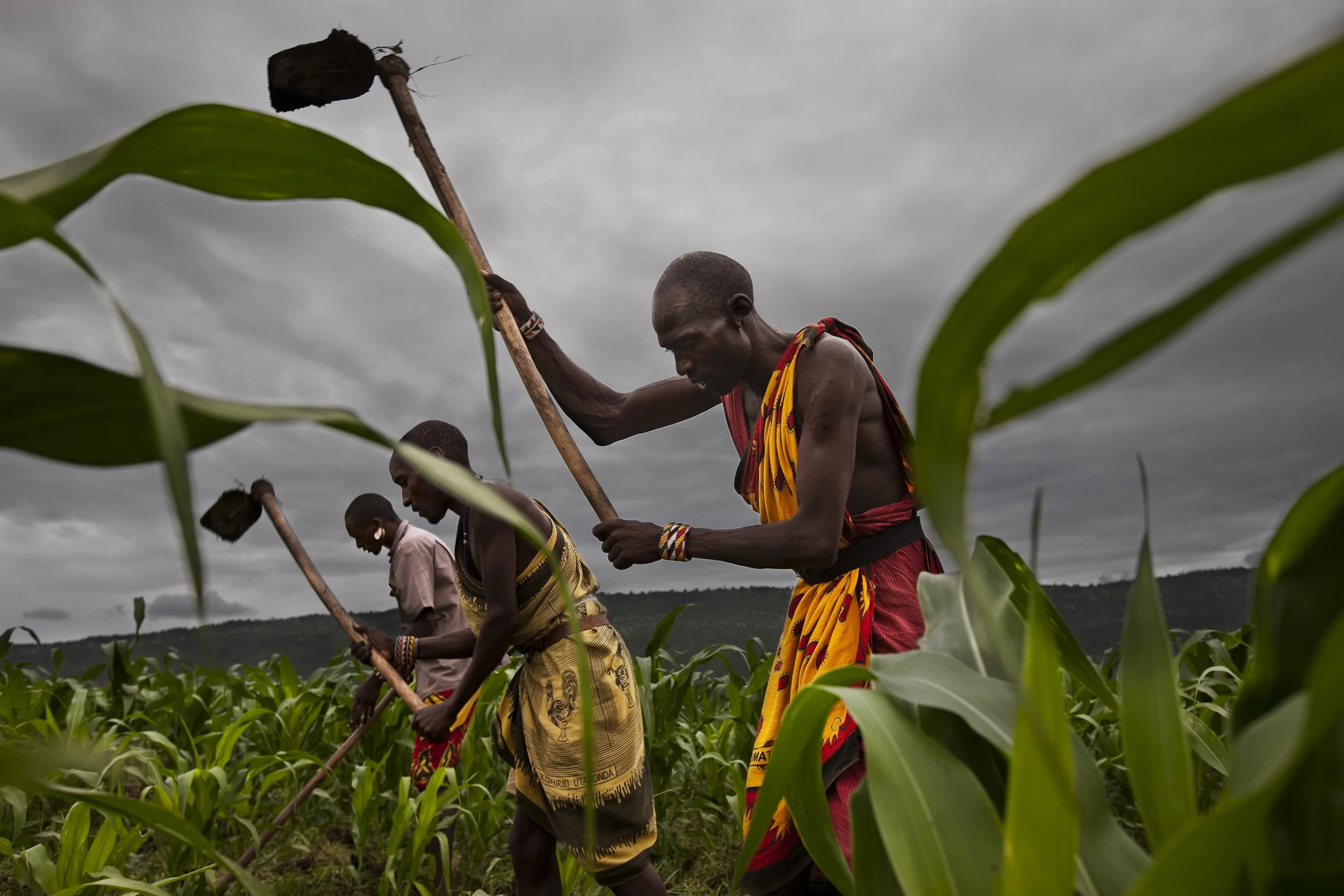
ORNGAYANET, NAROK SOUTH, KENYA, FEBRUARY 2010: Pastoralist Masaai prepare a field of Maize in Orngayanet, Kenya, 22 February, 2010. Crop cultivation is a relatively new thing for the Masaai, and is a result of living next to other tribes who practise agricultural and have fared better than the Masaai with their cattle in times of drought and disease and shrinking grazing land. There are now large fields of maize under cultivation by the Masaai as some move from pastoralism towards a more stable means of income and subsistence. The main priorities of the Pastorilists around Kenya is access to medical treatment, education for their children and access to water for good grazing. The culture around cattle however means that selling them for money for these purposes is often a reluctant process. As land for grazing diminishes and drough and climate change and overpopulation loom, these practises will have to change if pastoralists are to move into a modern way of life. (Photo by Brent Stirton/Reportage by Getty Images.)

LAKE TURKANA, NORTHERN KENYA, MAY 2010: Trained Dasenetch pastoralist men sift for hominid fossils at one of the sites of the Ileret Turkana Basin Institute in Lake Turkana in North Kenya, 20 May 2010. The Lake Turkana region is one of the greatest fossil fields in the world and the Institute seeks to employ as many local pastoralist people as it can as a way of translating the value of the area across multiple platforms, from academia, to tourism and local job creation. There are very few employment opportunities in this region and the pastoralist Dasenetch and Turkana people are very enthusiastic about the Institute as a result. There are plans to grow the Turkana Basin Institute significantly into an internationa phenomenon, this may being further jobs to the area for the local pastoralists. Climate change, globalisation, education, drought and overpopulation are just some of the reasons why pastoralist culture in Kenya is changing. (Photo by Brent Stirton/Reportage by Getty Images.)
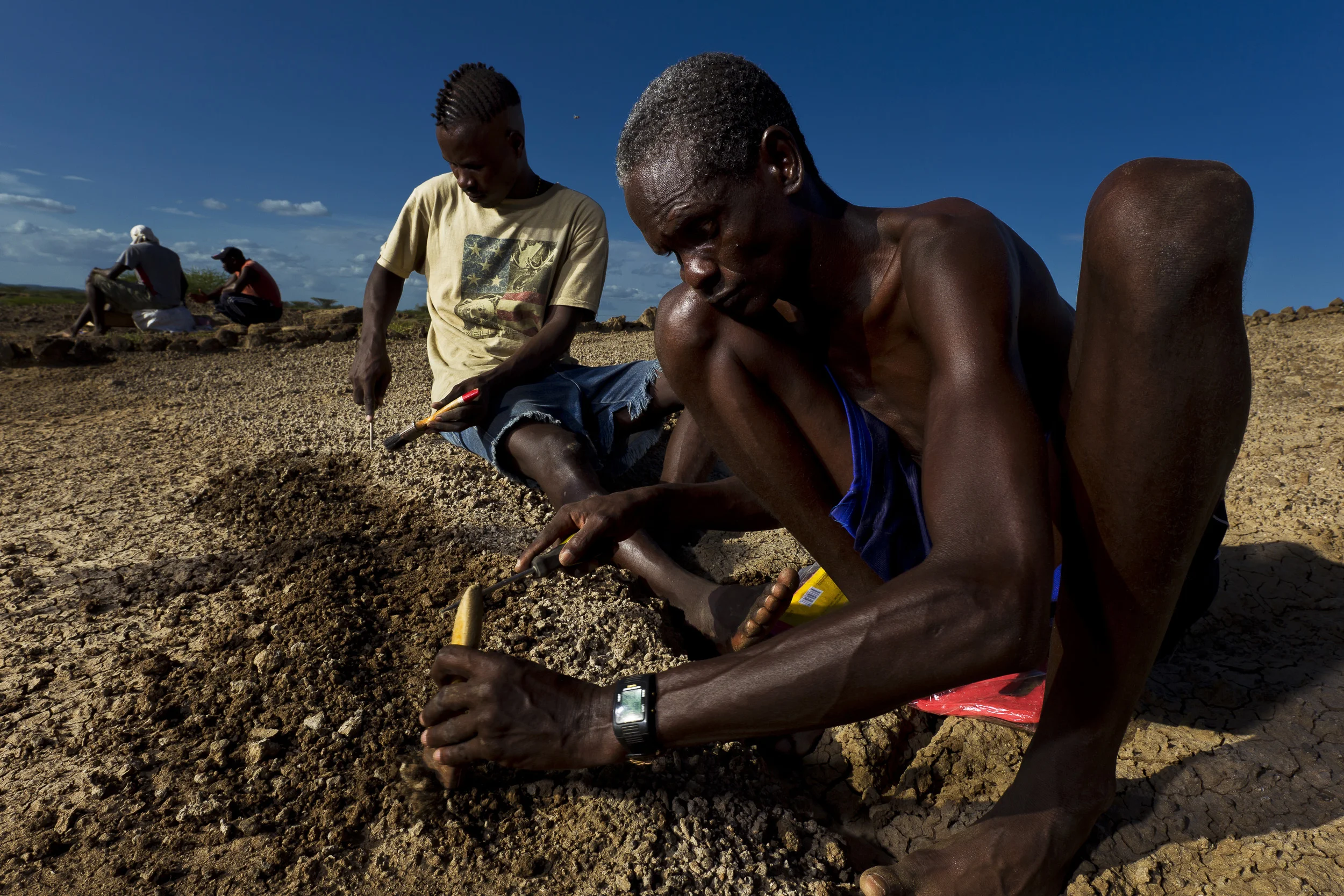
LAKE TURKANA, NORTHERN KENYA, MAY 2010: Trained Dasenetch pastoralist men sift for hominid fossils at one of the sites of the Ileret Turkana Basin Institute in Lake Turkana in North Kenya, 20 May 2010. The Lake Turkana region is one of the greatest fossil fields in the world and the Institute seeks to employ as many local pastoralist people as it can as a way of translating the value of the area across multiple platforms, from academia, to tourism and local job creation. There are very few employment opportunities in this region and the pastoralist Dasenetch and Turkana people are very enthusiastic about the Institute as a result. There are plans to grow the Turkana Basin Institute significantly into an internationa phenomenon, this may being further jobs to the area for the local pastoralists. Climate change, globalisation, education, drought and overpopulation are just some of the reasons why pastoralist culture in Kenya is changing. (Photo by Brent Stirton/Reportage by Getty Images.)

LAKE TURKANA, NORTHERN KENYA, MAY 2010: Yierat Lonyakwanga, 70, a Dasenetch pastoralist sits with 4 of his 6 wives and some of his 43 children in northern Lake Turkana in North Kenya, 22 May 2010. Polygamy has long been a sign of prosperity and prestige for many of the pastoralist tribes of Kenya. This practise however has become far less sustainable as overpopulation has surged and there have been less favourable climate and resultant drought in Kenya. Education as to womans rights as well as basic education is also changing this practise. Yeirat blames the lack of rainfall and increased land pressure on the bloodshed that resulted between the tribes as a result of cattle conflict but in reality it is as a result of the introduction of the AK47 in the region and the continued pressures of climate change, overpopulation and water issues between the competing pastoralist groups. (Photo by Brent Stirton/Reportage by Getty Images.)
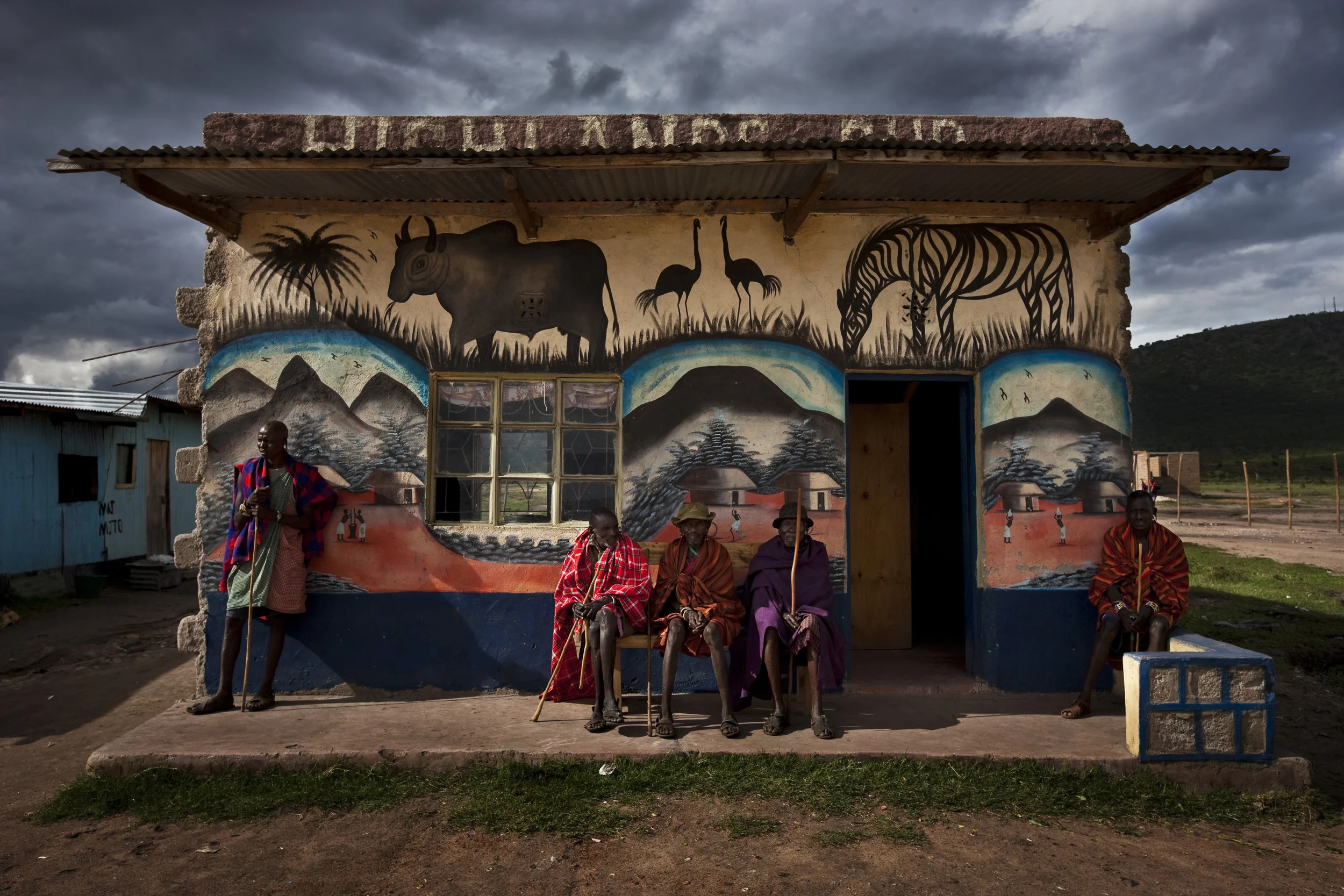
ORNGAYANET, NAROK SOUTH, KENYA, FEBRUARY 2010: Masaai elders sit outside a bar in a town which has grown up outside one of the gates of the Masaai Mara National Reserve, Orngayanet, 22 February, 2010, Kenya. This is a recent occurence, the elders would previously be found in the village dispensing wisdom and sitting under trees with their cattle in the distance. As their land has shrunk, populations mushroomed, droughts have impacted, the Masaai are increasingly in touch with the western world. A steady erosion of their culture is a result. (Photo by Brent Stirton/Reportage by Getty Images.)


NAIROBI, KENYA, FEBRRUARY 2010: Urban pastoralist Masaai at Wilson Manyatta, close to Wilson airport, who originally moved to Nairobi 20 years ago from Kajiato district for better grazing and rainfall, Nairobi, Kenya, 26 February 2010. These urban Masaai are experiencing ever increasing land pressure as Nairobi becomes a thriving metropolis where land is more and more valuable. Due to their pastoralist nomadic lifestyle, these Masaai have little claim to land unless they fence it and place permanent structures on the land. Even so, government planning, voracious business models for development and no real political representation mean these Masaai are permanently under threat of removal. (Photo by Brent Stirton/Reportage by Getty Images.)
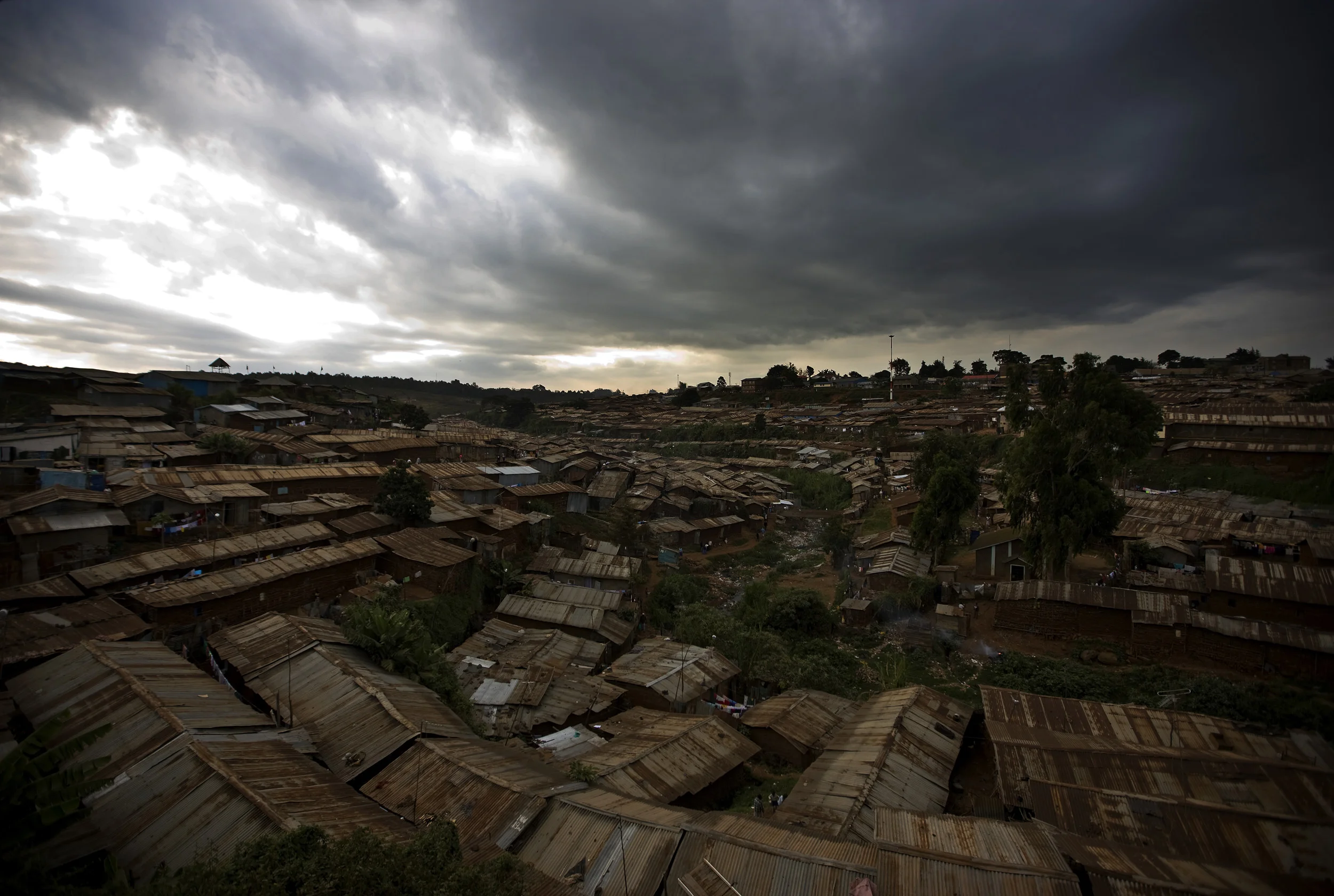
Kibera Slum outside of Nairobi, one of the largest slums in Africa and a place where many former pastoralists who have made their way to the city now call home.
